

REPORT ON
PHOTJAUD VILLAGE UNDER MAWKYRWAT C&RD BLOCK
DISTRICT: SOUTH WEST KHASI HILLS
COMMUNITY LED LANDSCAPE MANAGEMENT PROJECT



The Government of Meghalaya with the financial help from the World Bank has been implementing the Meghalaya Community Led Landscape Management Project (MCLLMP). The project covers the entire state of Meghalaya and implementation of community led plans have been rolled out in phase manner throughout the state. The Meghalaya Basin Management Agency (MBMA) had facilitated the community-led planning by providing support, technical inputs and funding.
The project had strengthened community-led natural resources management in selected landscapes within the 12 districts of the state. This has been achieved through a variety of planning, capacity building, and on-the-ground interventions to promote the conservation, sustainable use of natural resources, social inclusion and community mobilisation; building traditional knowledge and learning, mapping of natural resources management; strengthening the community institutions and creating linkage with financial institutions and community organizations.
The project interventions include the preparation of community led natural resource management plans. The CLLMP has the following three components:
Strengthening Knowledge and Capacity of Communities for Natural Resources Management
Community-Led Landscape Planning and Implementation
Project Management and Governance
The project objective is “to manage and conserve the natural resources, especially forests, soil and water sources, in a manner that supports the financial and physical well-being of communities in the State”
SCOPE:
The CLLM-Programme focuses on increasing the capacities of communities and traditional institutions (TI) by adopting a landscape approach to manage their natural resources such as soil, springs and other water sources, forests and bio-diversity, etc.
The project has been planned and implemented in about 400 villages across the state.
CLLMP has a strong focus on institution-building at the village-level, by ensuring systematic capacity-building on technical and social skill-sets.
The project has also extended such trainings to communities beyond the targeted villages and support efforts made by them to access funding from various rural and natural resources initiatives and schemes.
The programme has also invested in improving the process and outcome delivery, by developing and adhering to effective systems and procedures, supported by the appropriate technology.
BENEFITS:
Benefits for community (Skills and Capacity relating to technical and managerial areas like NRM and Conflict resolution
Benefits to traditional institutions (village councils, traditional leaders, community-based organizations, SHGs etc) through Knowledge sharing, promotion of innovative approach, access to technology, technical managerial and financial support.
It has been estimated that the project has impacted around 1 lakh partners (of which 50% are women) who depend on land, forest, agro forestry.
Through the project, 55000 Ha of targeted area has been ensured with availability of water, biological resources and soil productivity, which has in turn benefitted around 400 villages and the outcomes delivery can be summarized as follows.
IMPLEMENTATION AGENCY:
The Project has been executed by the MBMA in collaboration with other partners particularly, SIRD (for training and capacity building), Department of Soil and Water Conservation, Water Resource Department, Forest Department, specifically with respect to technical inputs, safeguards management and Community NRM plan preparation.
PROJECT PERIOD:
2018-2023 (5 years)
TABLE OF CONTENTS:
Introduction & Village History………………………………………....5
Social Profile ………………………………………………………….6
Village Accessibility…………………………………….. 6
Literacy rate……………………………………………. 6
Population……………………………………………... 6
Occupation…………………………………………….. 7
Village organisation……………………………………. 8
Fuel Type………………………………………………8
Drinking Water………………………………………...8
Cultivatable Land………………………………………9
Forest Cover…………………………………………….9
Forest Species……………………………………………9
Water Bodies…………………………………………….9
Areas affected………………………………………….10
CLLMP Activities
Ground-Truthing………………………………………………….10
Sensitization on CLLMP…………………………………………10
Signing of EOI, VGA and Green Charter……………………….11
Formation of VNRMC…………………………………………...11
Village Community Facilitators………………………………….12
Purchase Committee ……………………………………………..12
Opening of Bank Account …………………………….……………….13
PRA Exercise……………………………………………………………14
Basic Survey for CNRMP template………………………………14
Focussed Group Discussions……………………………………15
Village Boundary Mapping and Resource Mapping……………17
GIS Activities……………………………………………………………17-19
The Proposal list of intervention…………………………………………20
Project Implementation ………………………………………………...21-38
Fund Status ……………………………………………………………….39
Ground Testimonials ……………………………………………………….40-43
INTRODUCTION:
Photjaud village is situated in South West Khasi Hills District under the Mawkyrwat C&RD Block. The village is about12Km away from the District Headquarters i.e., Mawkyrwat and about 10Km away from the Block Headquarters. It has a total geographical area of 210.63Ha and falls under the Hima Maharam Syiemship. Photjaud village has a total population of 1380 comprising of 681 males and 699 females. All the residents of Photjaud village belonged to the Khasi Scheduled Tribe. The average rainfall of Photjaud village is 12000mm and the type of soil is mainly Sandy soil.

BRIEF HISTORY OF THE VILLAGE:
Photjaud village is located on top of the hills of the Riwar area under the Hima Maharam Syiemship. The village was named after its surrounding areas as there is a river that lies at the foothills of the village and “Phot” literally means “River” while “Jaud” is a green plant that grows on the river side and that was how this village gets the name “Photjaud”. The first resident of this village was from Mawtngam who were cattle rearers belonging to the clan Shylla, Shangdiar, Syiemlieh, Jyrwa and Khyllem Kharai and as told by the elders of the village, these clans have settled here long before the year 1866 as this year was recorded by the Church.

Fig: Photjaud village.
VILLAGE SOCIAL PROFILE:
Photjaud village has a total number of 165 households, having a total population of 1380 villagers. People in this village mainly depend on agriculture and its allied activities for their livelihood. There are teachers, daily labourers but the majority of the villagers depend mostly on agricultural farming.
Village Accessibility:
In order to reach Photjaud village one must travel through road with local taxis, Maxi cabs or bus from the Mawkyrwat-Photjaud road via Nonglang village.
Literacy Rate:
In Photjaud, there are a total number of 5 schools out of which 4 are Primary Schools and there is 1 Secondary School in the village. Many of the people are literate.
Population:
The total population of Photjaud village now stands at 1380 as of the recent survey. Out of this,681 are male and the female count is 699.This village has 193 children belonging to the group 0-4years and 73 people are above the age of 60. About 312 total number of people belong to the age group of 30-60 years, and 15-30 years are the age group that comprises of a total of 508 people. Thus, this indicates that the majority of the population of Photjaud village comprise of the young and healthy people.
| Age Group | Male | Female | Total |
|---|---|---|---|
| 0-4years | 88 | 105 | 193 |
| 5-14years | 159 | 135 | 294 |
| 15-30years | 241 | 267 | 508 |
| 30-60years | 161 | 151 | 312 |
| Above 60years | 32 | 41 | 73 |
| Total | 681 | 699 | 1380 |
Occupations:
The people of Photjaud village rely mainly on agriculture and forest produce for their livelihood. Out of 165 households within the village, 90 household are farmers, 40 household are teachers, while the remaining 35 household are landless labourers.
Organisation within the Village:
There are 18 Self Help Groups (SHGs) under NRLM in Photjaud village under one Village Organisation. Presence of a committee relating to Water and Sanitation within the village. There are also 8 VEC & traditional institutions within Photjaud village.
Fuel Type:
The people of Photjaud village mainly uses wood as a fuel. About 170 households depend on wood gathered from the forest for their daily requirement.
| Type of Fuel | Total No of HH | Qty (Kgs/HH) | Total |
|---|---|---|---|
| Wood | 170HH | 6000kg | 10,20,000kg |
| Charcoal | 20HH | 35kg | 700kg |
| LPG | 50HH | 75kg 5Cylinder per year |
3750kg |
Drinking Water:
The people of Photjaud have access to drinking water mainly from the springs within the village. Government water supply lines are also available in this village. But over the years there has been a scarcity of water supply in this village due to less water discharge from the springs source and due to the increase in human population and their daily requirements. There are 2 springs which fall under the community land within the village which are perennial that people use for drinking viz. Photsangshong and Twah Jaud in which all 165 household are depended on.
Cultivable Land Cover:
The total agricultural area of Photjaud village is 0.13Ha. The type of soil in Photjaud village is Loamy soil. People practise bun cultivation and shifting cultivation in their own private lands. The main cash crop of Photjaud village is Broomstick. Most of the lands falls under private ownership. The areas that people cultivate broom are Nongbsaw, Mawtemksein, Wahdilin, Wahleper and Raiiawlam. They also plant other cash crops such as beetle leaf and bay leaf. The areas that people practise shifting cultivation for a period cycle of 3years on are: Malkhrang, Breikhrew, Breisyien, Kaintangbew, Photditung.
Forest Cover:
The total forest cover under Photjaud village is 77.51Ha. The majority of the forest cover falls on the Community Forest and the quality of the forest is moderate. The name of the community forest are: Shnongsaw, Reimission, Khlaw Kyntang, Khlawjaud, Photumrwiang, Tynrong Mawjaw, Twah Bah, Twah Mawsiar, Twah Rangiang, Domioppudra, Domphetkhniang, Saitsohphan, Twah Thangmawbor, Twah Phot Pyrnon, Tiehbah, Khlaw Synrangpongpa. People uses the forest products mainly for fuelwood, as medicines, aromatic plants and for other purposes. There is one Clan Forest at Mawphet which is an open forest that belongs to the clan “Shylla”.
Forest:
Some of the indigenous tree species found in this village are Diengtanglung, Diengsohstap, Diengngan, Diengsning, Diengdoh, Diengsohryted, Sohshynrut, Dienglanbor, Dienglyngba, Diengsohpian, Diengsohsairat, Diengraitlong, Diengsohkhyllam, Diengroiiang, Diengrailong, Diengphylut, Diengkrut, Diengrang, Diengpe, Diengsohkhyliang, Diengjri, diengjyler, Diengsnamaw, Dienglieng, Diengsawum, Dienglangarop, Diengtlai. There are some plant species used by the people of the community for medicinal purposes like Sohphie, Sohshynrut, Sohlamut, Sohot, Sohbrai, Sohjyrmi, Sohlang, Sohshylit, Sohrangblang, Sohbrap, Sohparu, Sohtongkhur, Sohkynphur, Sohryted, Jhur: Jane, Jasih, Jatira, Battusaw, Batsohmarit, Batsohkhai, Batnepbru, Batjajiew, Sohiong, Sohot, Sohpriam. Some of the valuable grasses in the forest are Phlangtongkhar, Phlangsohru, Phlangprut, Phlangshiang. Raimission ia a protected forest within the village. The forest is also home to many vulnerable fauna-like wild birds, clouded leopard, and rabbits.
Water Bodies:
Total area of water bodies in Photjaud is 6.36Ha. There are 2 springs within the village which have been mentioned above which people use mainly for drinking purpose. Some of the streams within the village are Wah Jaud (1.42ha) and Twahmawsiar (1.4ha) which falls under the community land. Both the streams are seasonal and serves about 165 household.
Areas Affected:
Approximately about 8.79ha of forest land have been degraded over the years due to soil erosion, 4.3ha due to forest fires, 7.98ha excessive felling of trees and 6.72ha have been degraded due to Jhum practises which have led to the loss of productivity of the land and the loss of the saplings and other natural resources About 0.13ha of cultivable land have been affected by the excessive use of fertilizers and 5.69ha of land have been degraded over the years owing to human settlement and culturable wastelands.
CLLMP ACTIVITIES:
Ground Truthing: The CLLMP officials met with Mr.Twinklingstar Shangdiar headman of Photjaud village, Mr.Selwesroy Shylla the village Secretary and other village representatives for field assessment. Mr.Shangdiar, provided the CLLMP Team with important information regarding the current scenario of the landscape and the natural resource management under his headman ship.
Case Findings:
Most of the household falls under the BPL category.
They have an actively performing VEC in the village.
The land within the village falls under the Hima Maharam Syiemship.
The source of water supply in the village is from two sources: private and public.
There are a few patches of degraded land that has been left unused.
There is a loss of Natural Vegetation in the area.
Abundance of small streams within the village.
Sensitization Programme:
The District Project Manager Mr.J.Wanniang along with the staff held a village Level Sensitization Programme on the Community Led Landscape Management Project (CLLMP) on 1st July 2019.The villagers actively participated in the program, voicing out their concerns and questions regarding the project making it a huge success
Highlights of the meeting:
Awareness about the Community Led Landscape Management Project (CLLMP).
Laying the importance on the involvement of the community in making the CNRM plan and its success.
A brief awareness on cleanliness was conducted based on our finding during the ground truthing phase.
An interactive session was held to answer doubts of the villagers regarding the project.
Signing of EOI, VGA and Green Charter:
On 1st July 2019, Photjaud village signed the EOI (Expression of Interest), VGA (Village Grant Agreement) and the Green Charter after there was a uniform agreement by the people of the entire Community that the Community Led Landscape Management Project (CLLMP) be implemented at Photjaud village.
Formation of the VNRMC:
The formation of the Village Natural Resources Management Committee was done in a public meeting on the 1st July 2019 in the presence of the entire village and the CLLMP Staff. The people of the community chose the President, The Secretary, the Purchase Committee members and the other Executive members to formed the Photjaud VNRMC. There are 9 Executive members, 3 Village community Facilitator and 3 Purchase Committee members. The VNRMC Plan was later formulated on the 29th July 2019 in the presence of the VNRMC members.
List below are the members of the VNRMC:
| Village Natural Resource Management Committee (9members committee constituted from Village Council, SHG group, Women’s group, youth, VEC) | ||||||||
|---|---|---|---|---|---|---|---|---|
| Sl No. | Name | Designation | Gender (M/F) |
Age in years | Qualification | Occupation | Community | Phone No. |
| 1. | T.Shangdiar | President | Male | 55 | HSSLC | Teacher | Khasi | 6009672503 |
| 2. | Medakerlin Shangdiar | Secretary | Female | 45 | VII | Labour | Khasi | NA |
| 3. | W. Shylla | Finance | Male | 61 | HSSLC | Govt. Servant | Khasi | 7005703557 |
| 4. | L. Snaitang | Member | Male | 60 | VI | Govt.servant | Khasi | 7005672696 |
| 5. | S.S Shylla | Member | Male | 50 | HSSLC | Labourer | Khasi | 6000092500 |
| 6. | P.Lyngdoh | Member | Male | 48 | HSSLC | Govt.Servant | Khasi | NA |
| 7. | M.Shylla | Member | Female | 54 | IV | Labourer | Khasi | 7005672696 |
| 8. | T.Shylla | Member | Male | 38 | Dp Mech. Engg | Govt. Servant | Khasi | 7005672696 |
| 9. | P.Syiemlieh | Member | Female | 49 | IV | Labour | Khasi | 9366226625 |
| Village Community Facilitators (VCF) | ||||||
|---|---|---|---|---|---|---|
| Sl. no. | Name | Age | Gender | Qualification | Contact Number | Role |
| 1. | Rockfeller Shylla | 21 | Male | BA | 8837450874 | Evt & GIS |
| 2. | Iaraplang Shylla | 23 | Male | BA | 6009016851 | SM & KM |
| 3. | Beatrice Lyngkhoi | 22 | Female | BSC | 6009347633 | ME & PM |

| Procurement Members | |||||
|---|---|---|---|---|---|
| Sl no. | Name | Age | Gender | Qualification | Contact Number |
| 1. | Trustfulman Shylla | 38 | Male | Dip.Mech Engg | 70056 72696 |
| 2. | Maltidoris Shylla | 48 | Female | X | 6009351486 |
| 3. | Selwesroy Shylla | 51 | Male | X | 6000092500 |
Fig: VCF of Photjaud Village.
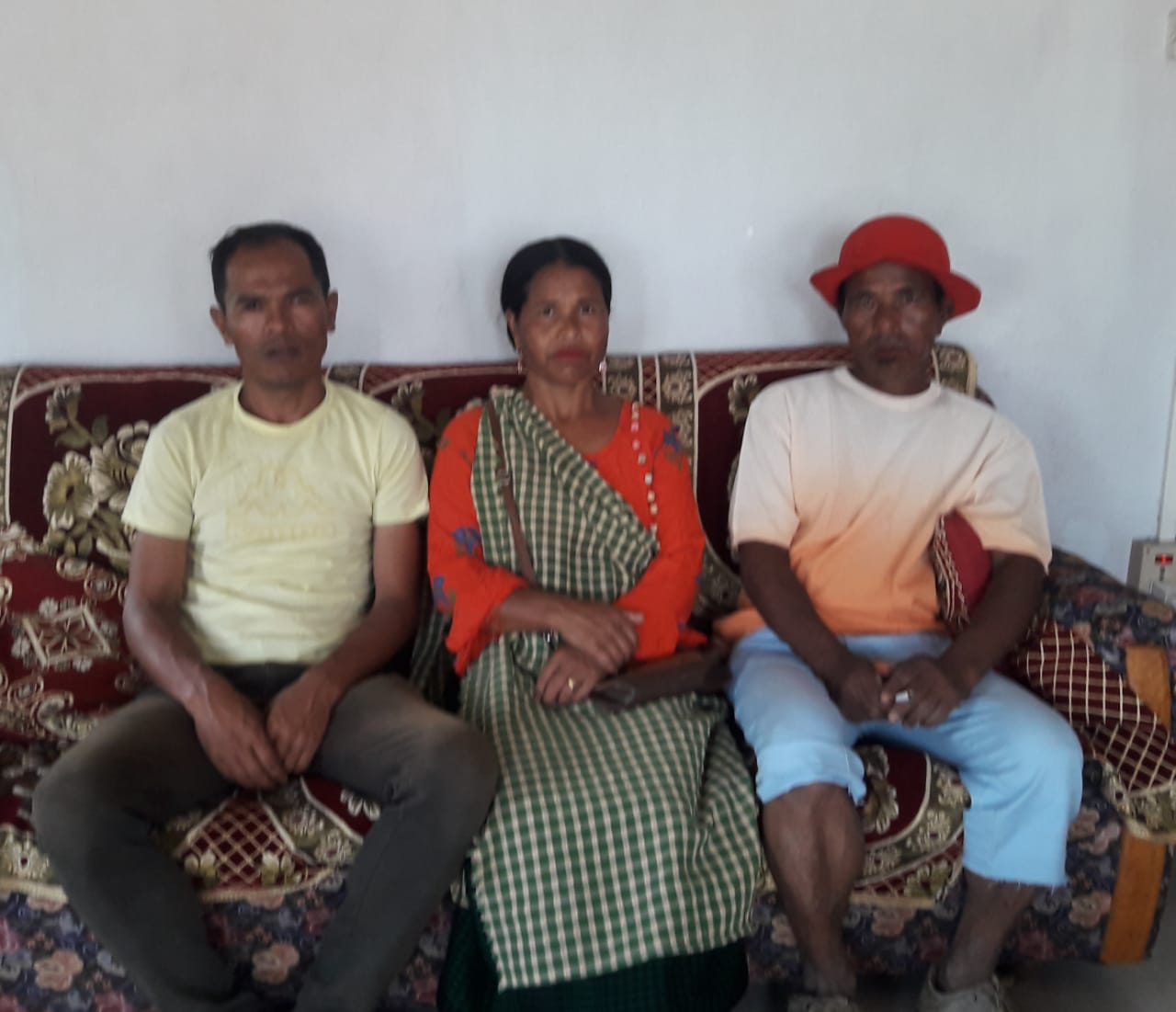
Fig: Purchase Committee Members.
Opening of Bank Account:
The opening of the bank account was done after the signing of the EOI (Expression of Interest), the VGA (Village Grant Agreement) and the signing of the Green Charter. The Accountant of CLLMP South West Khasi Hills trained the Purchasing and Procurement Committee of Photjaud village on matters relating to Accounts and Book Keeping and on the:
Principles of Community Procurement
Benefits of Community Procurement
Important aspects undertaken by Community Procurement.
Procurement Process/Steps
Function of Purchase Committee
Important Procurement records to be maintained
Financial limits and methods
Maintaining of Books of Accounts to the Book Keeper.
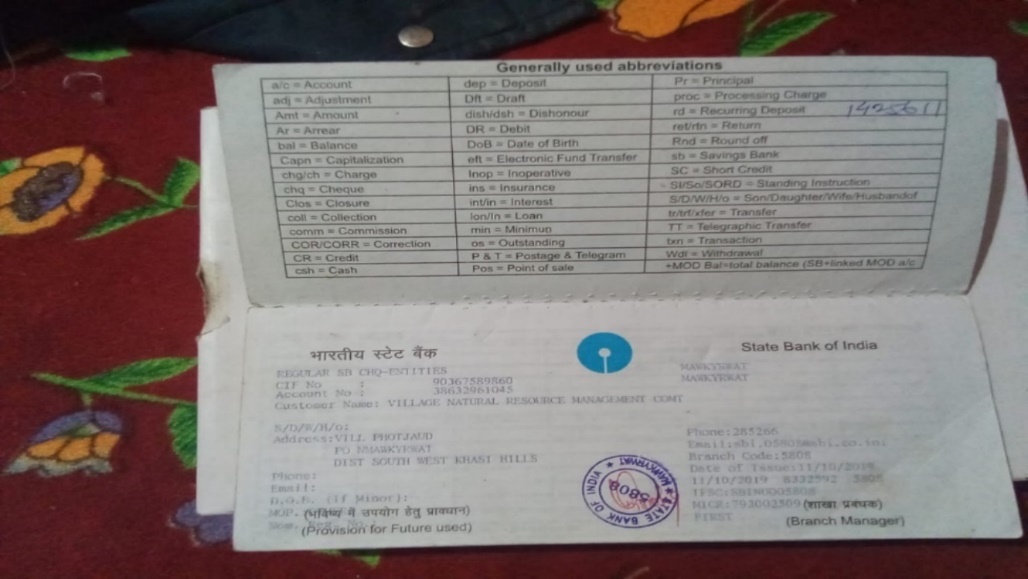
Fig: Bank details of Photjaud VNRMC.
6.Participatory Rural Appraisal Exercise:
The PRA exercise aims to incorporate the knowledge and opinions of the community in the planning and management of development projects and programmes.
The PRA exercise took place on the 1st July 2019 both men and women attended the program.
The District Project Manager gave the introduction and spoke about the different activities that the participants had to take part in the programme.
The Program Associate, Environment Management, spoke about the different CNRM plans and the different types of intervention. A group of participants interacted and helped in the collection of data based on the environmental template. With the help of this group, different sites of interventions were identified, analysed and evaluated in order to prioritized the areas that needed the natural resources management.
The Assistant Manager, Social Management, gathered the remaining group of participants to gather the baseline data bases on the social template.
The main objectives of PRA exercise are:
To identify the natural, human and economic resources of the village.
To identify the village problems and prioritized them with the help of the community members.
To prepare the community natural resources management plan of the village.
Findings based on the information gathered from the participants during the PRA/CNRMP exercise:
1. The main agricultural produce is Broomstick, Beetle leaf and Bay leaf.
2. Most of the household depend on firewood as a source of fuel.
3. Drinking water is limited over a period of 3-4 months during the winter season.
4. There are two types of forest ownership: Community and Clan.
5. There is one Protected Forest.
6. The springs which are present in the village needs rejuvenation.
7. Training on Land productivity, Spring shed management and Community nursery is necessary for the village community.
8. There are no disputes/constraints encountered within the village community or with any neighbouring villages.
Priorities Intervention required based on the PRA Exercise:
1. Rejuvenation of the Springs within the community through activities such as afforestation, treatment of catchment areas and contour trenches.
2. Afforestation, Bio-fencing and fire line control in the community forest.
3. Community Nursery for endemic trees.
4. A dug out pond for collecting rain water for.
5. Check dams for erosion control.
6. Culturable wastelands to be brought under horticulture.
7. Retaining wall in some area in the village to prevent soil erosion.
Baseline Data Survey to fill the Environment and Social
Template:
During the PRA Exercise the External Expert of Social & Environment Management held a group discussion with the different groups to gather basic village information regarding number of households, demographic information, major crops and enterprises taken in the village, trends of production and productivity of major crops in the village and demographic distribution of village population.
Information related to land use category such as forest, cultivable land, water bodies, etc and the problems and challenges related to NRM were discussed.
Focussed Group Discussion on Problem Analysis:
Do people have sufficient access to supply of fodder, fuel wood, leaf litter?
No, people in the village do not have sufficient access to supply of fodder, fuel wood, leaf litter.
Has access to timber improved or reduced over the years? How is access for household use and commercial use managed?
Access to Timber has reduced over the years. People have to purchase it from neighbouring village when needed.
Are the water bodies facing any threats?
So far, the water bodies within the village have faced some minor threats.
Do all people in the village have access to drinking water? What are the challenges?
Yes, there is sufficient drinking water in the village except during the winter season due to from December up to March due to less discharge of water from the spring source.
Are there degraded areas in the village (open/ degraded forests, mining affected, high soil erosion etc.)?
There are some minor degradations in cultivated land.
What has caused this degradation? Are there practices causing threats to availability and access to natural resources?
Fertility of the soil has decline over the year.
The practices that cause threat to the availability of these resources is:
Excessive practice of Jhum Cultivation
What have been the changes in agricultural practices?
Previously their method of farming is Shifting Cultivation, but over the years with much awareness people have begun to understand the effects of Jhum Farming method.
Are there any challenges in farming?
The main challenges faced by the people of Photjaud village is that over the years they have seen a decline in the soil productivity due to soil erosion and other plant diseases and pest that destroy their crops.
How would you consider the health situation in your village?
The nearest health care is in the district headquarter with a distance of 11Km away and is easily accessible for the community as a whole to commute to the health centre.
How is the situation of cleanliness, sanitation, access to toilets and waste management?
Sufficient toilets are available in every household but most of the constructions are poor. Some households have access to toilets from SBM (Swash Bharat Mission) scheme. The presence of VWSC in the village has also improve sanitation and cleanliness. But Waste Management is poor because people are not really aware of how to properly disposed off waste.
Who are the most vulnerable in the village? What can be done to improve their lives?
BPL Families. Inclusion of BPL family members during project implementation
What are the livelihood aspirations of the youth? Are there any avenues available?
None, except daily wages labourers.
Do any committees/ institutions/ rules exist to manage and monitor natural resources in the village?
The VNRMC under the CLLMP is the main committee that is now in place to manage the natural resources in the village.
What are some of the major issues of conflict in the village?
Nothing related to NRM.
Have any of the above issues been discussed in village meetings?
NA
How do people resolve disagreements and conflicts?
All disagreements and conflicts are addressed by the traditional institution of village called the Village Dorbar.
7. Village Boundary Mapping and Recourse Mapping:
The GIS personnel along with the Village Community Facilitators mapped the village boundary of Photjaud village.
The village resource map is prepared by the people of the community. In this resource map, the local people prepare it by drawing it on chart paper. Recourses such as agricultural lands, wells, wastelands, cattle population, playgrounds, ICDS, churches, community halls, etc were mapped.
8.GIS Activities:
| Sl. No. | Parameters | Village Information |
|---|---|---|
| 1 | GPS Coordinates: | |
| i | Latitude | 25.323774 |
| ii | Longitude | 91.452536 |
| iii | Elevation Reading (MSL) | 1423m |
| 2 | Village Geographical Area (Ha) | 210.63ha |
| i | Total Forest Area (including community, Clan, Pvt Forest) | 77.51ha |
| ii | Total Area of Water Bodies | 6.36ha |
| iii | Total Area under Agri-Horticulture | 0.47ha |
| iv | Total Degraded land area (Ha) | 40.37 |
| 3 | Average Annual Rainfall | 12000mm |
| 4 | Soil Type | Loamy soil |
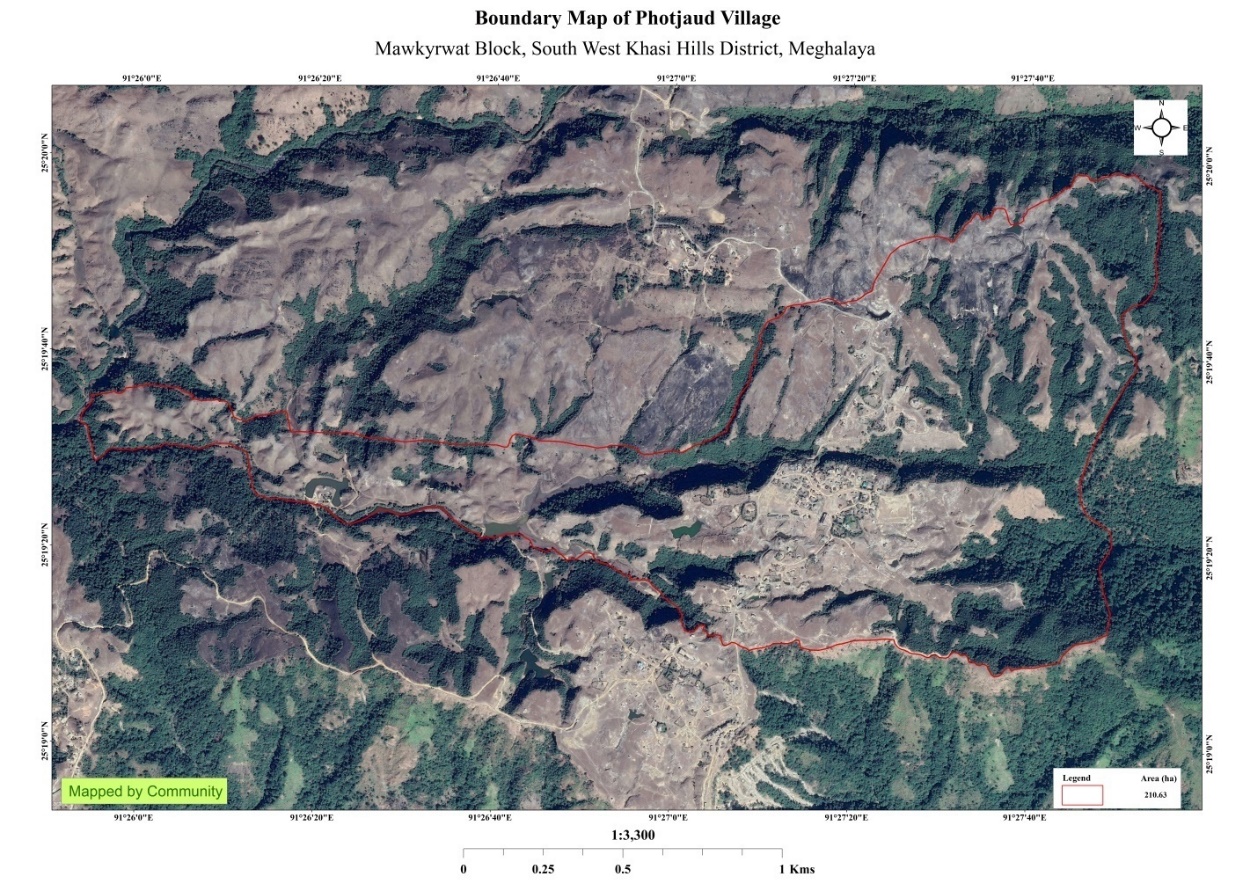
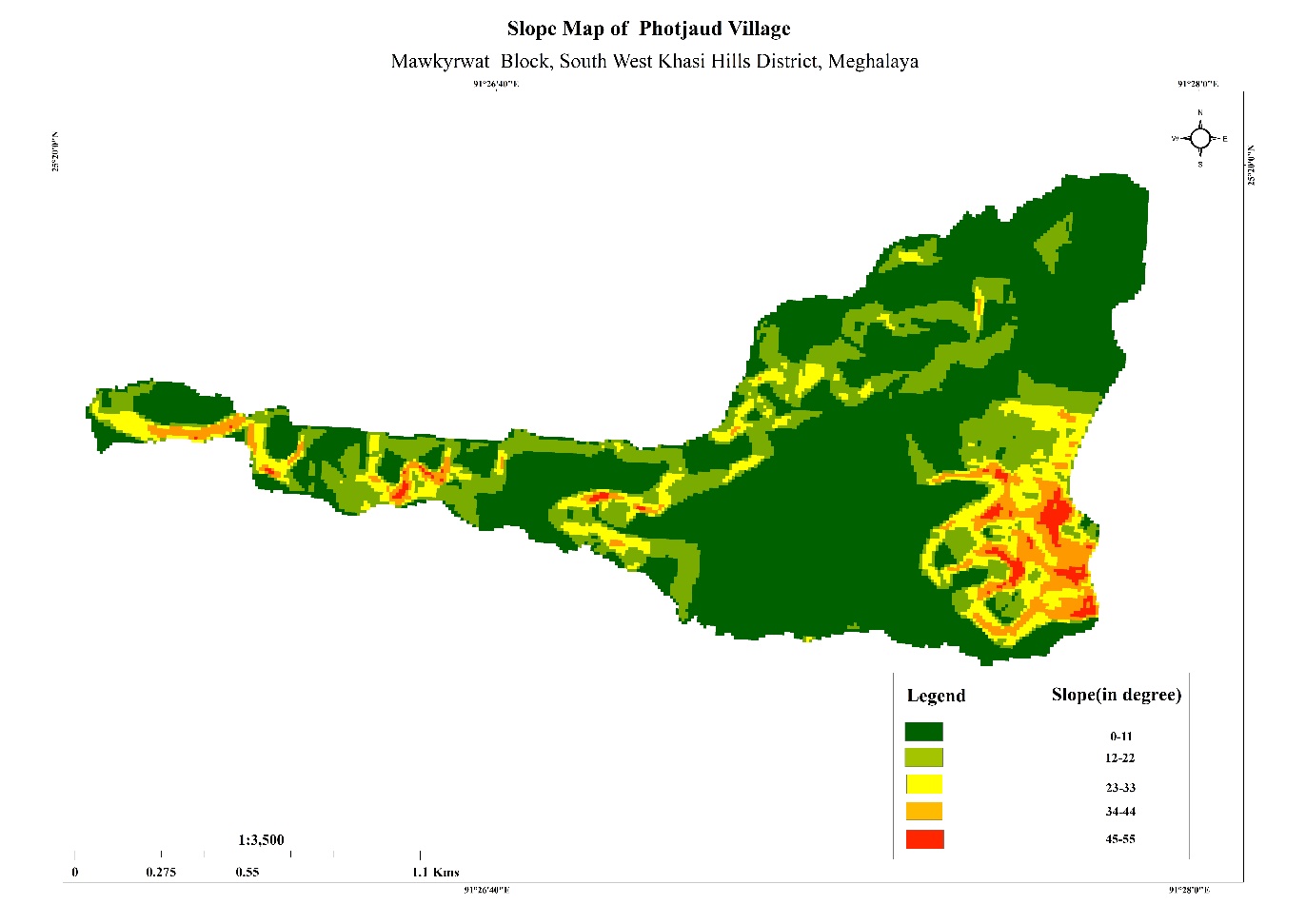

Fig: Boundary map, Slope map and LULC map of Photjaud.
9. The Proposed list of Interventions:
|
Name of Proposed Interventions | Site |
|
Nos of HHs expected to Benefit | Priority (High/ Medium/ Low) |
|---|---|---|---|---|---|
|
|||||
| 1. | Erosion control | Compound Iingmane Dongpdeng |
|
|
|
| 2. | SC and staggered trenches | Phodsangshong |
|
|
High |
| 3. | SC and staggered trenches | Tlongjaud |
|
|
High |
| 4. | Community nursery | Photjaud |
|
|
High |
| 5. |
|
Shnongsan |
|
|
High |
| 6. |
|
Domiappudro |
|
|
High |
| 7. | Afforestation | Tynrong Mawjam |
|
|
High |
| 8. | Afforestation | Tiehbah |
|
|
High |
| 9. | Afforestation | Tangpuhiar |
|
|
High |
| 10. | Afforestation | Saitsohphan |
|
|
High |
| 11. | Spring chamber | Twah mawsyiar |
|
|
High |
| 12. | Spring chamber | Twahmawsyiar |
|
|
High |
| 13. | Dug out pond | Saitsohphan |
|
|
High |
| 14. | Checkdam | Photshnong Nongsan |
|
|
High |
| 15. | Spring chamber | Twah raising |
|
|
High |
| 16. | Checkdam | Phot Mawjaw |
|
|
High |
10. PROJECT IMPLEMENTATION:
| 1. | Type Of Intervention | Site Name | GPS Co-ordinates | Amount Sanctioned | Work Status | |
|---|---|---|---|---|---|---|
| Erosion control wall at Compound Iingmane Dongpdeng | Iingmane Dongpdeng | 25.323852 | 91.454787 | Rs.2,30,410 | Completed | |
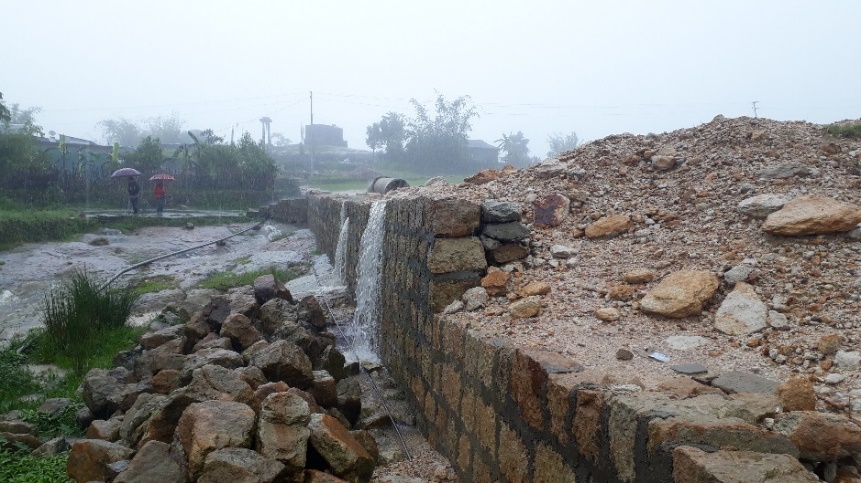
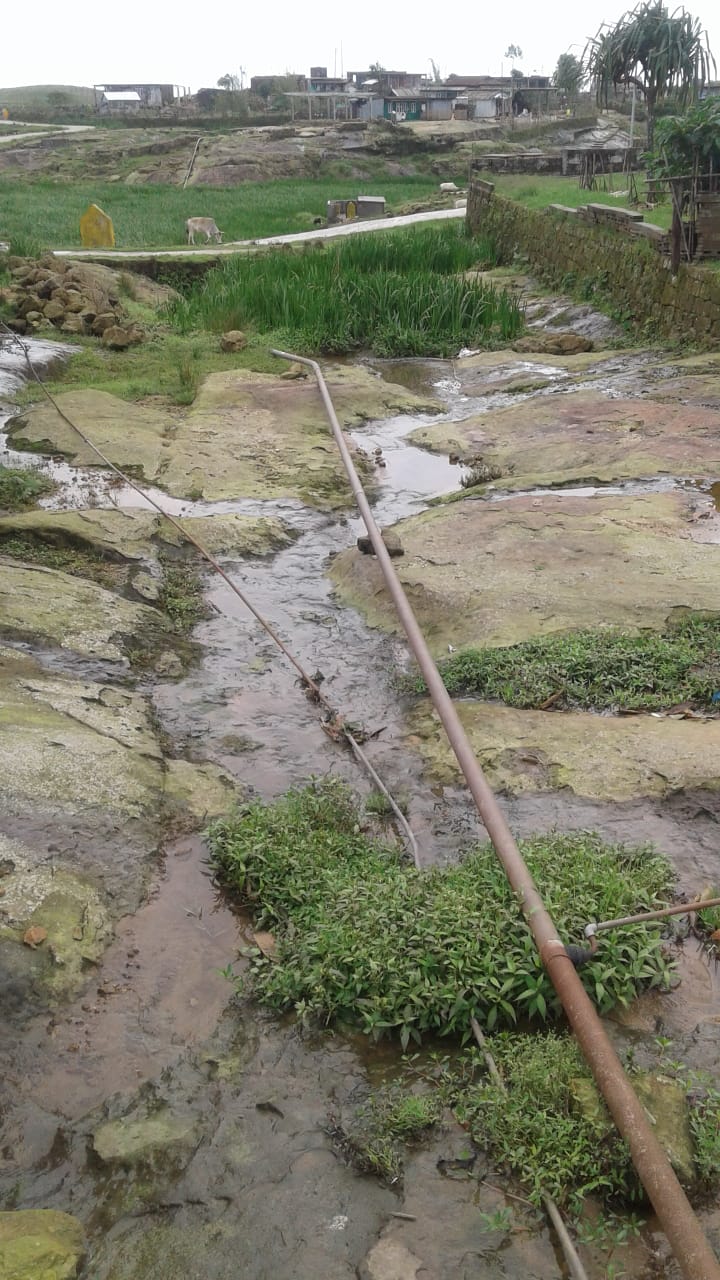
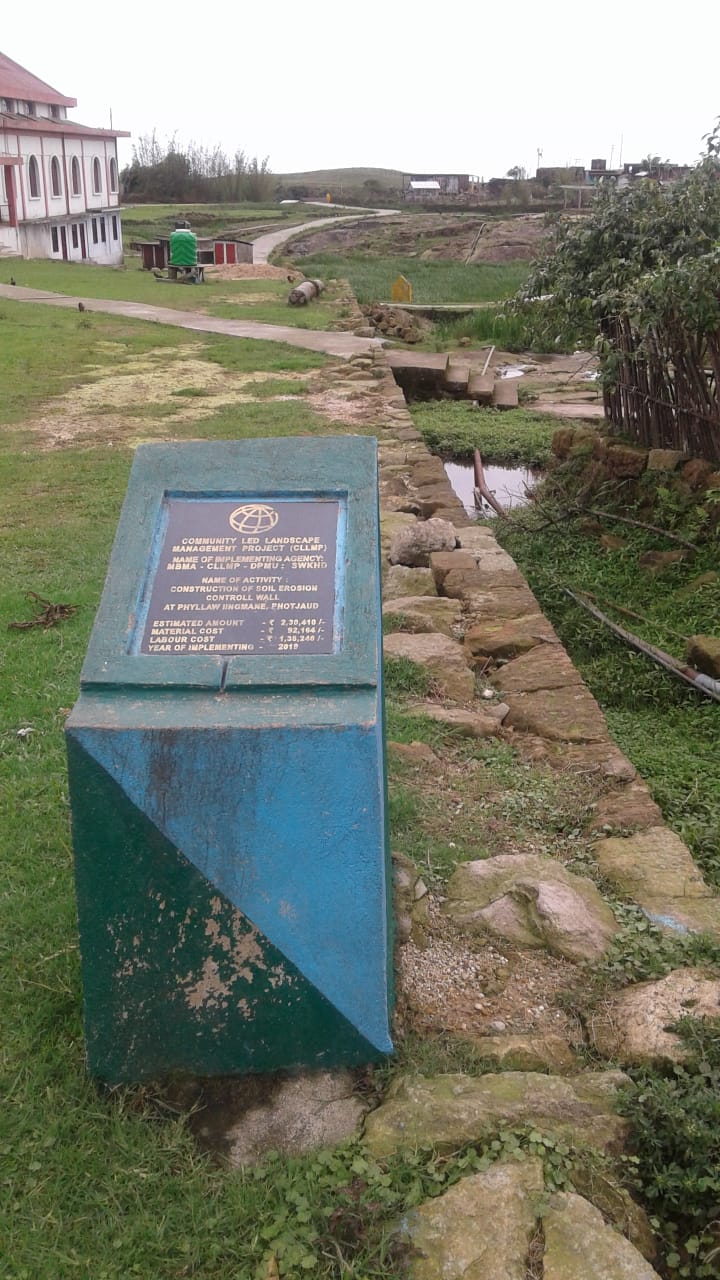
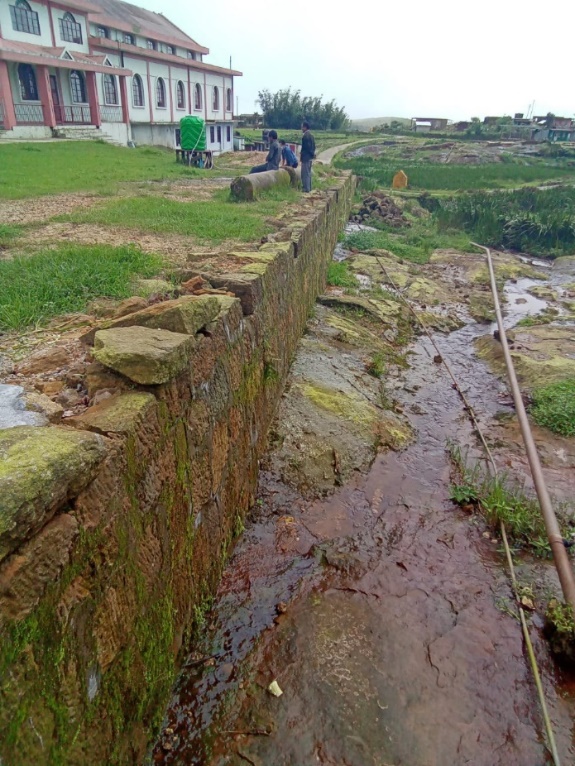
Fig: Erosion wall at Dongpdeng Church Compound.
| 2. | Type Of Intervention | Site Name | GPS Co-ordinates | Amount Sanctioned | Work Status | |
|---|---|---|---|---|---|---|
| Spring chamber and staggered trenches at Phodsangshong | Phodsangshong | 25.329162 | 91.456611 | Rs.45,760 | Completed | |
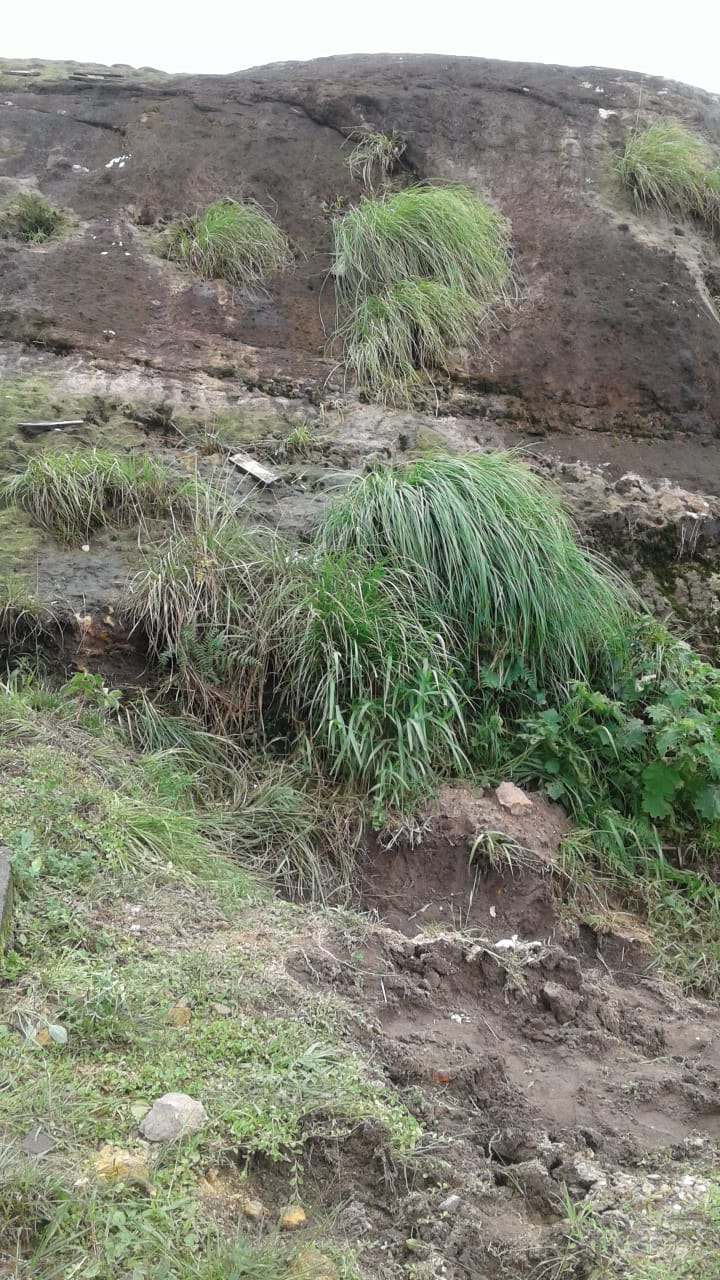
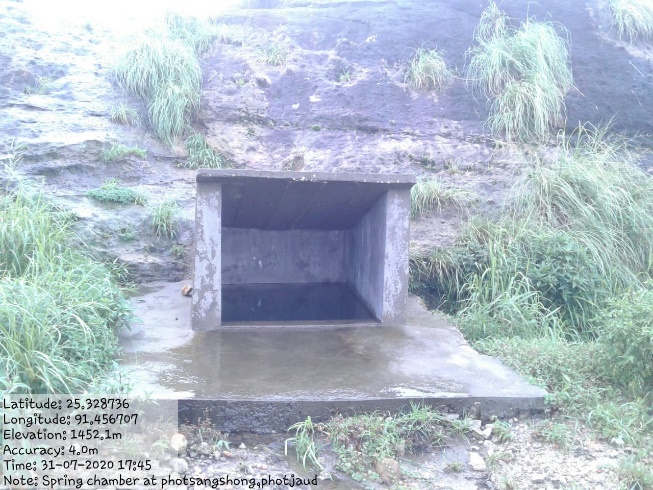
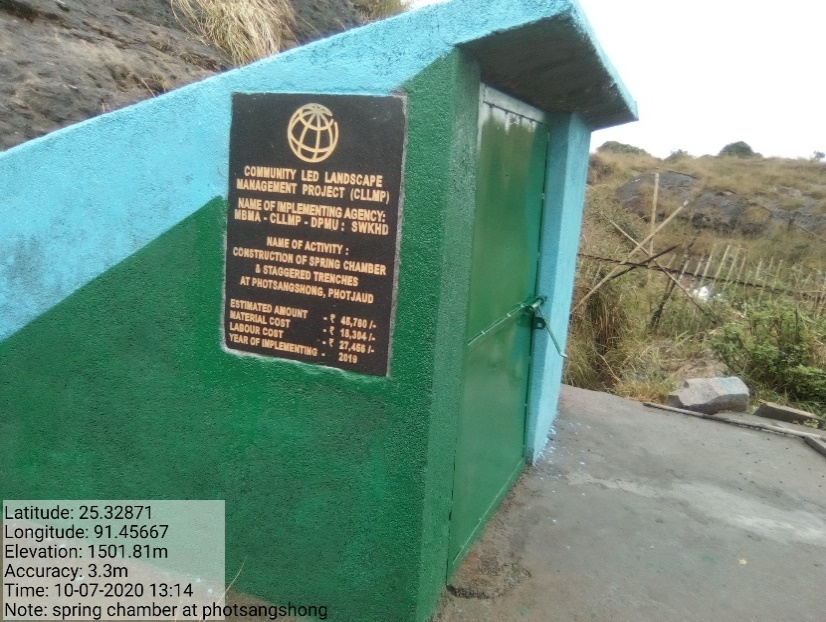
Fig: Spring Chamber at Photsangshnong.
| 3. | Type Of Intervention | Site Name | GPS Co-ordinates | Amount Sanctioned | Work Status | |
|---|---|---|---|---|---|---|
| Spring Chamber and staggered trenches at Twahjaud | Twahjaud | 25.324916 | 91.458459 | Rs.69,750 | Completed | |
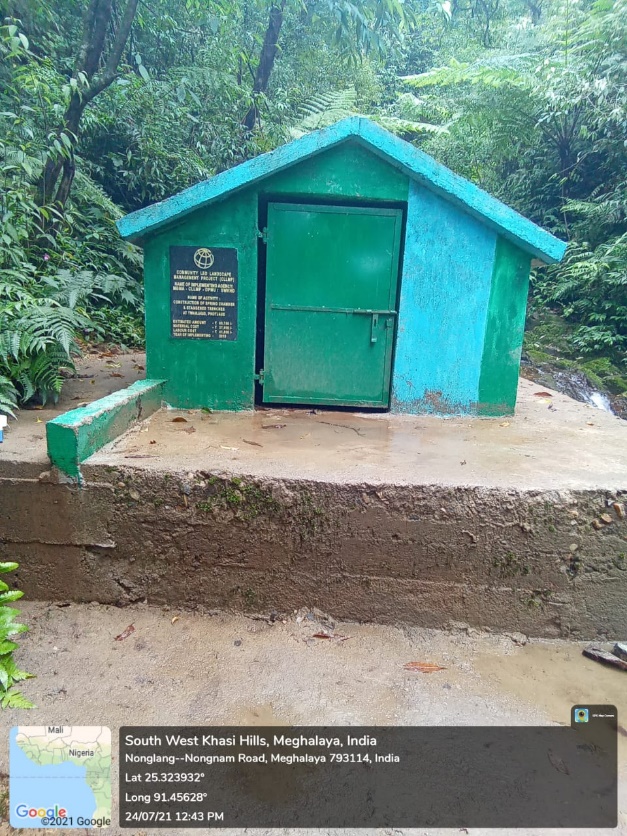
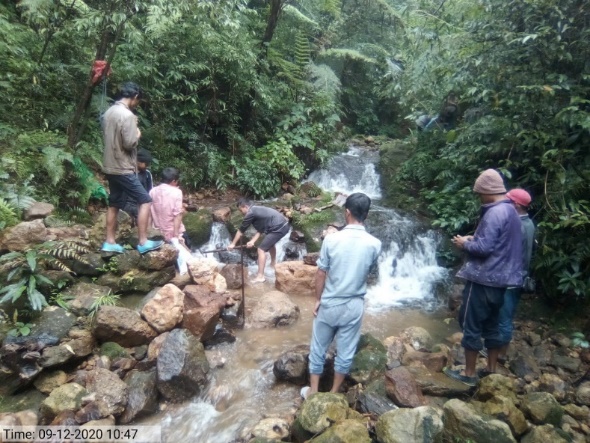
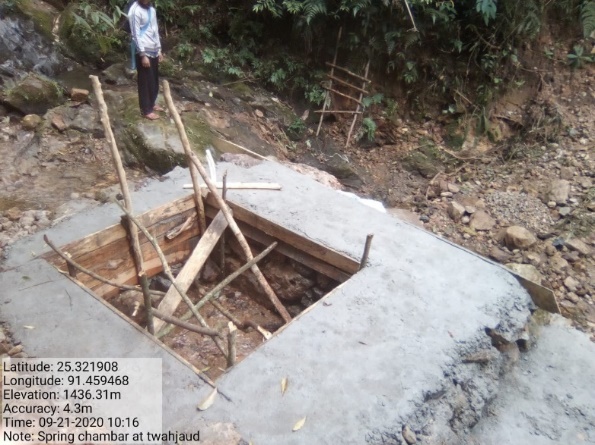
Fig: Spring Chamber at Twahjaud.
| 4. | Type Of Intervention | Site Name | GPS Co-ordinates | Amount Sanctioned | Work Status | |
|---|---|---|---|---|---|---|
| Community Nursery at Shongsang | Shongsang | 25.325733 | 91.458457 | Rs.2,97,280 | Completed | |
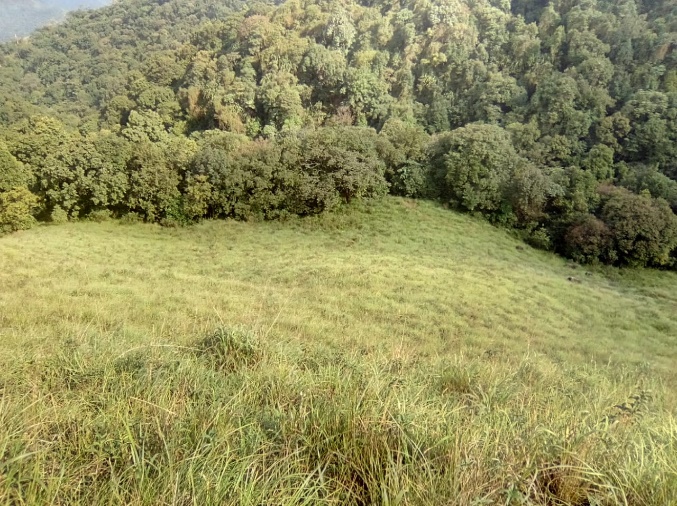
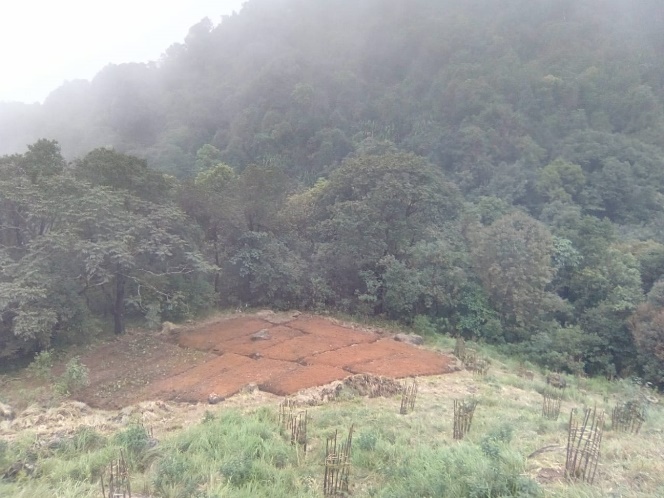
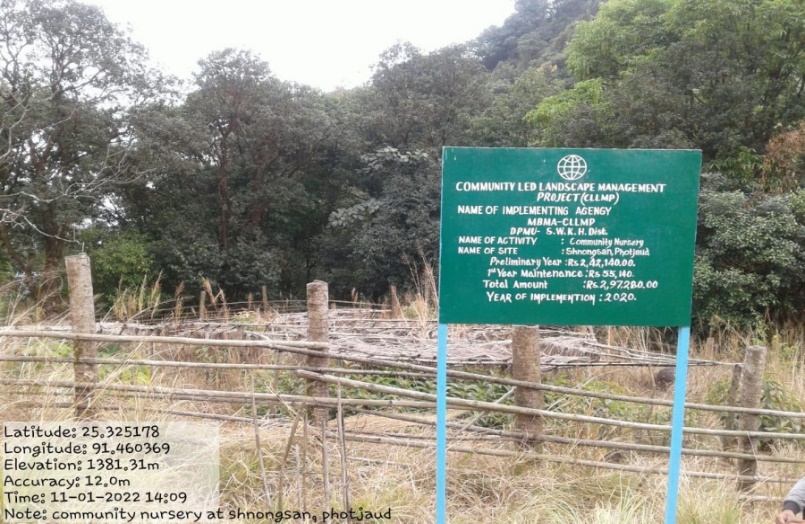
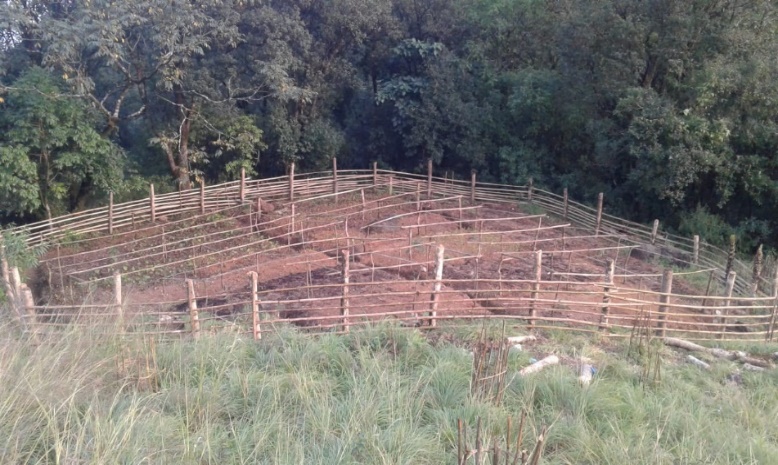
Fig: Community Nursery at Shongsang.
| 5. | Type Of Intervention | Site Name | GPS Co-ordinates | Amount Sanctioned | Work Status | |
|---|---|---|---|---|---|---|
| Afforestation at Shnongsan | Shnongsan | 25.324989 | 91.460304 | Rs.2,30,000 | Completed | |
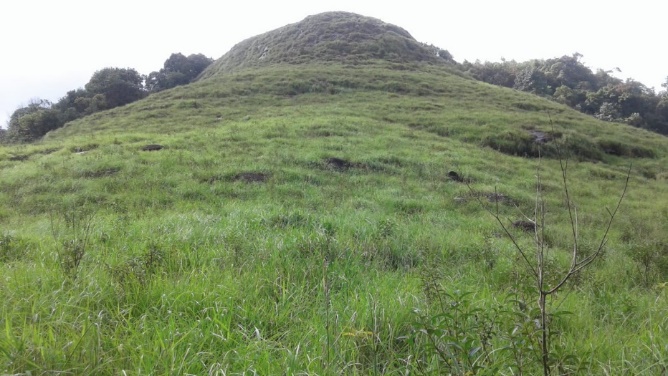
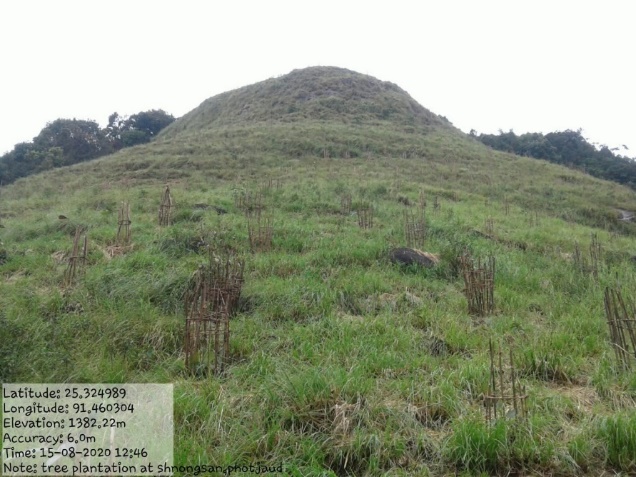

Fig: Afforestation at Shnongsang.
| 6. | Type Of Intervention | Site Name | GPS Co-ordinates | Amount Sanctioned | Work Status | |
|---|---|---|---|---|---|---|
| Afforestation at Domiappudro | Domiappudro | 25.328207 | 91.46166 | Rs.78,650 | Completed | |
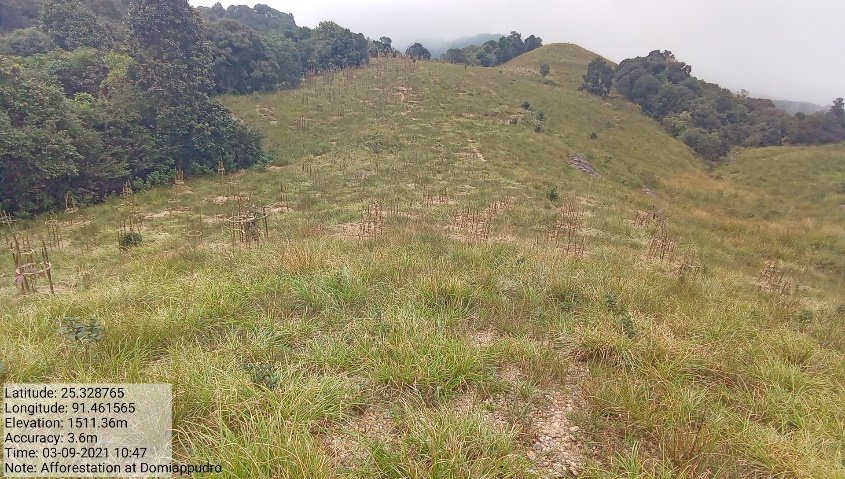
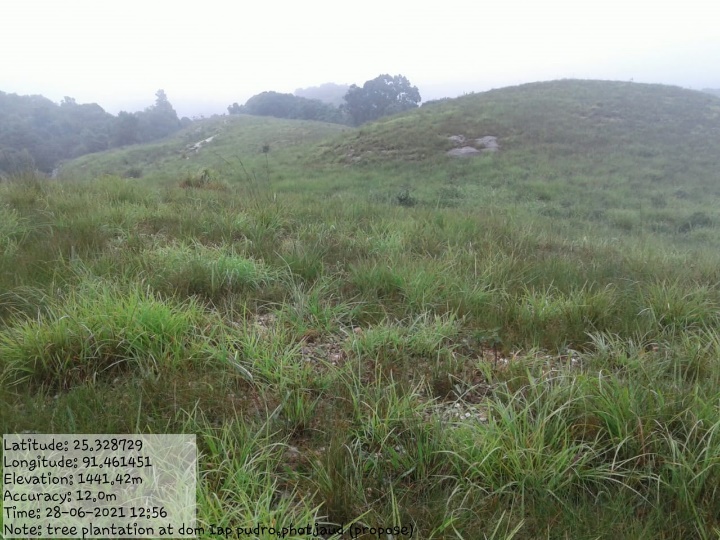
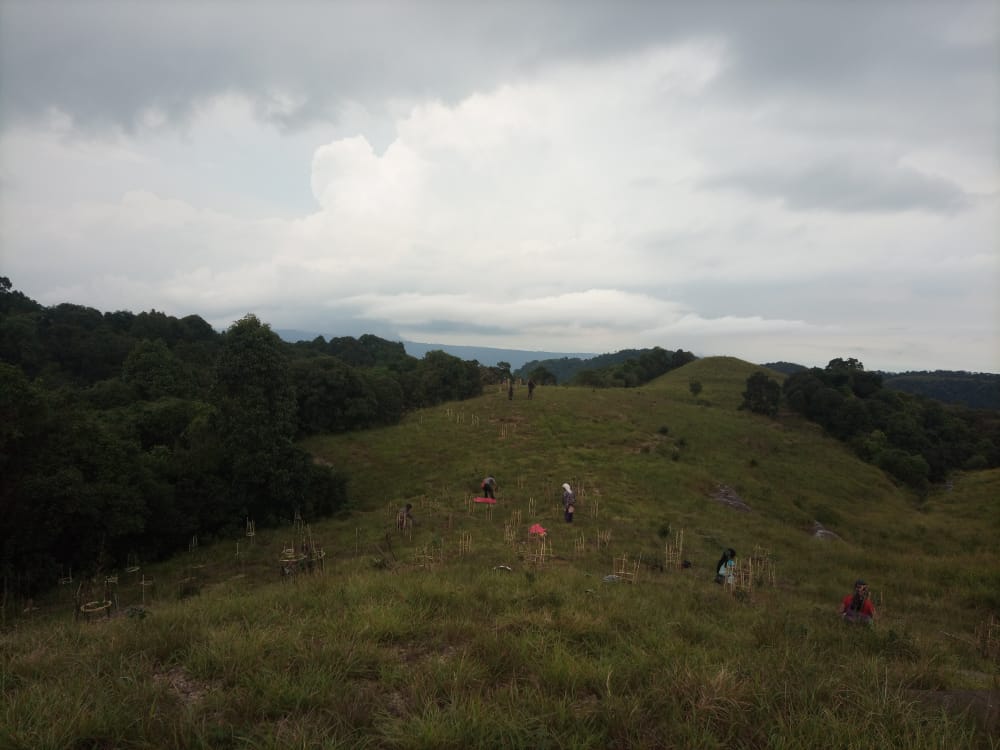
Fig: Afforestation at Domiappudro.
| 7. | Type of intervention | Site name | GPS co-ordinates | Amount sanctioned | Work status | |
|---|---|---|---|---|---|---|
| Afforestation at Tynrong mawjam | Tynrong Mawjam | 25.328419 | 91.463358 | Rs.1,33,910 | Completed | |
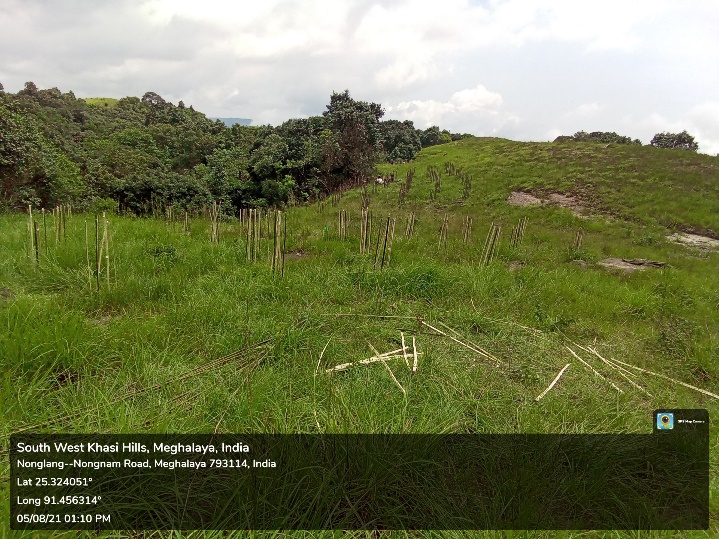
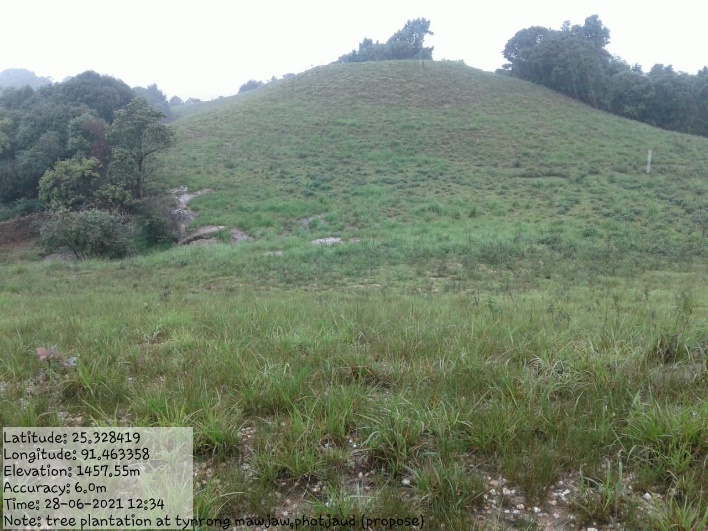
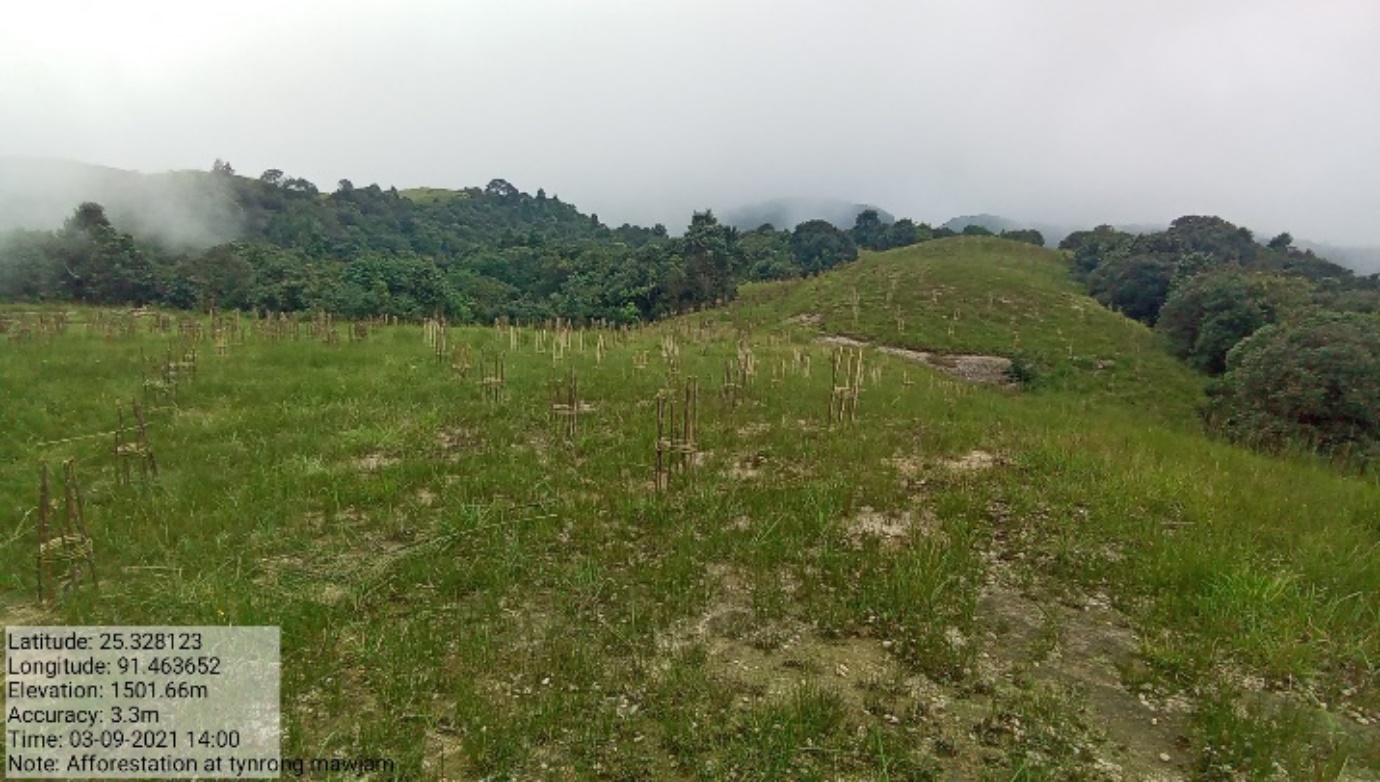
Fig: Afforestation at Tynrong Mawjam.
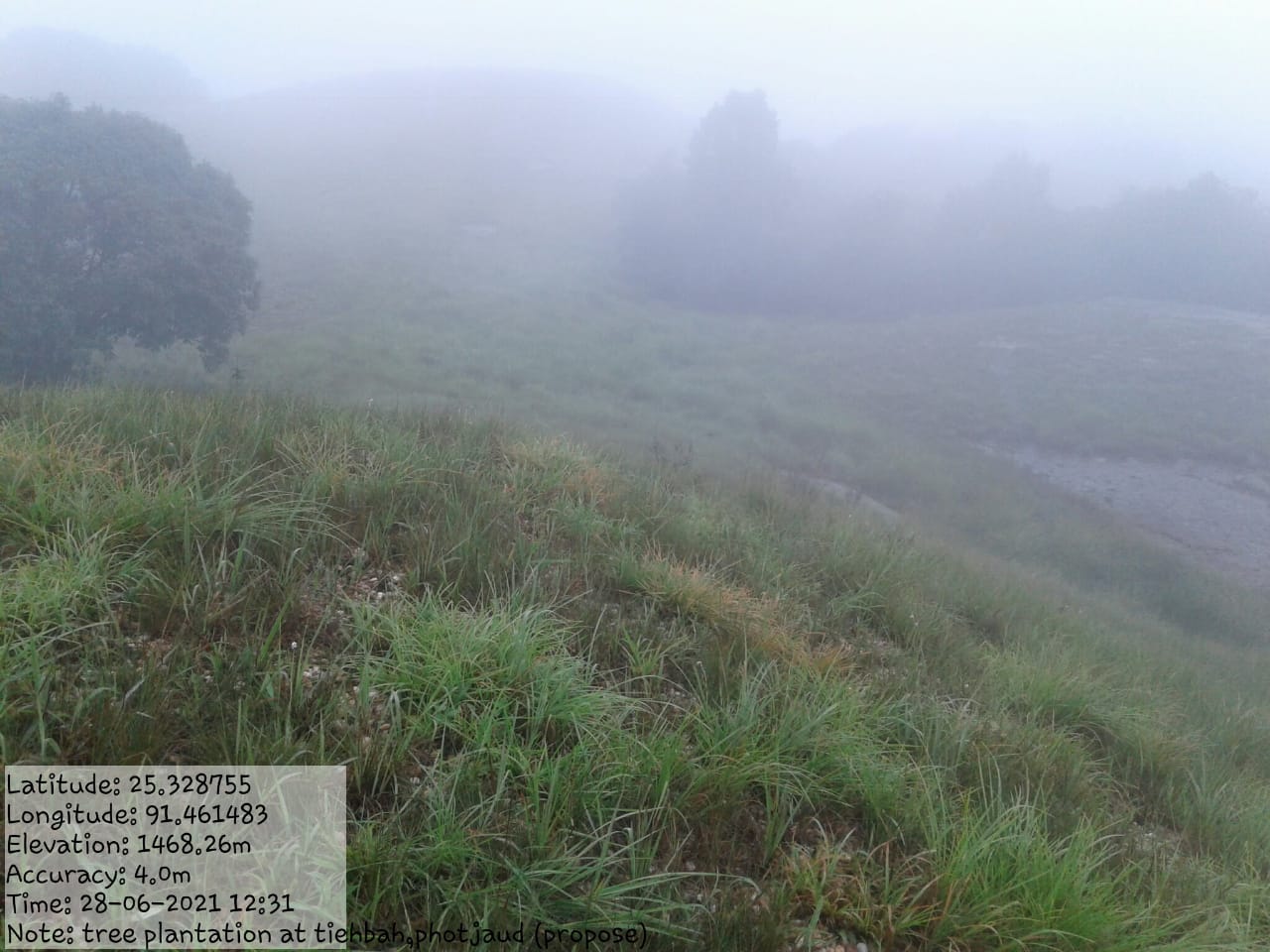
| 8. | Type of intervention | Site name | GPS co-ordinates | Amount sanctioned | Work status | |
|---|---|---|---|---|---|---|
| Afforestation at Tiehbah | Tiehbah | 25.329746 | 91.461278 | Rs.95,910 | Completed | |
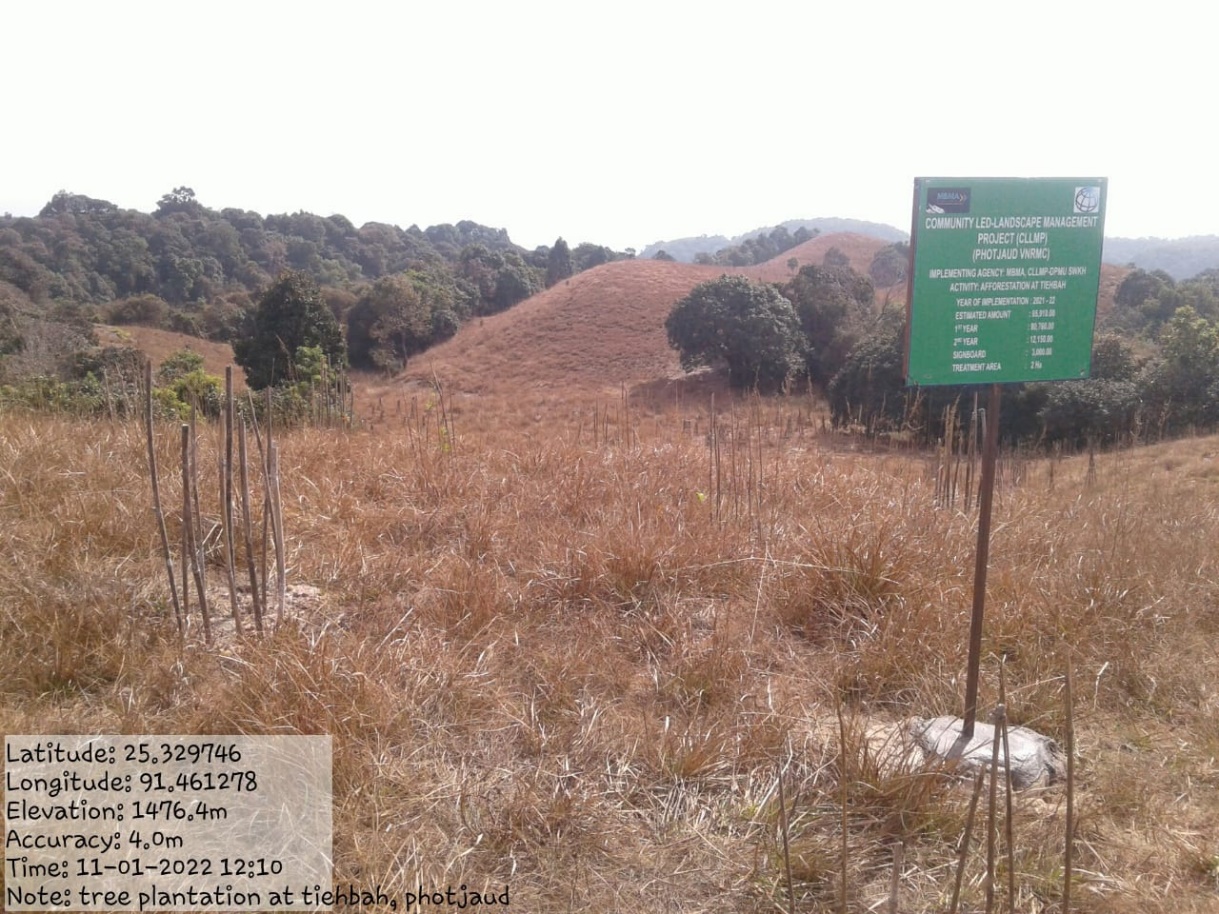
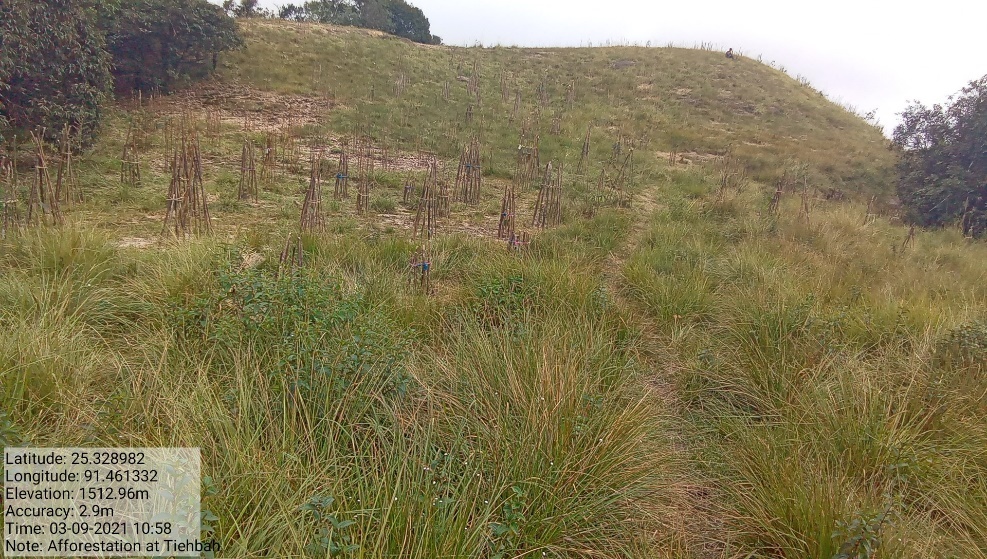
Fig: Afforestation at Tiehbah.
| 9. | Type of intervention | Site name | GPS co-ordinates | Amount sanctioned | Work status | |
|---|---|---|---|---|---|---|
| Afforestation at Tangpuhiar | Tangpuhiar | 25.323723 | 91.461378 | Rs.1,33,910 | Completed | |
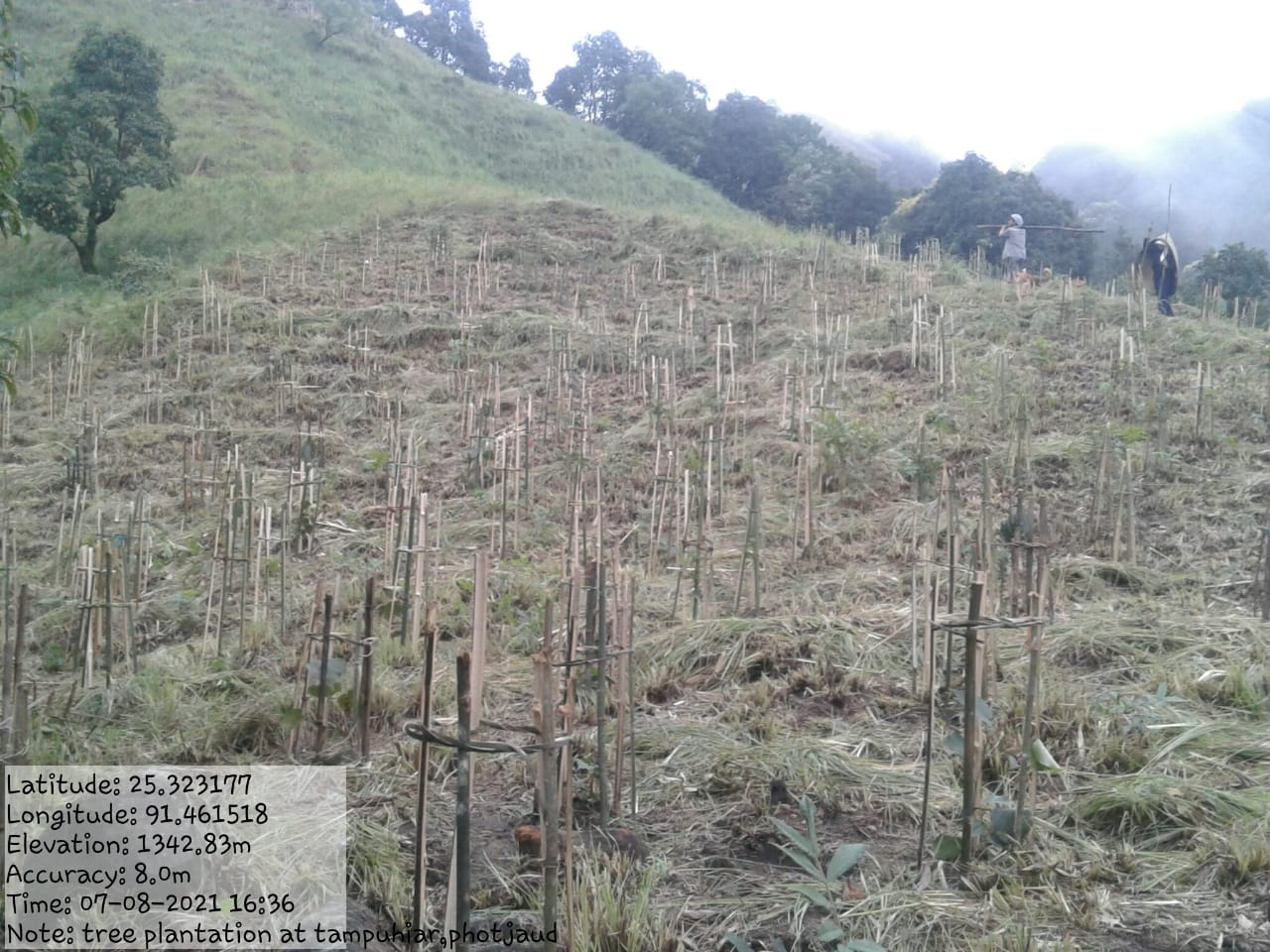
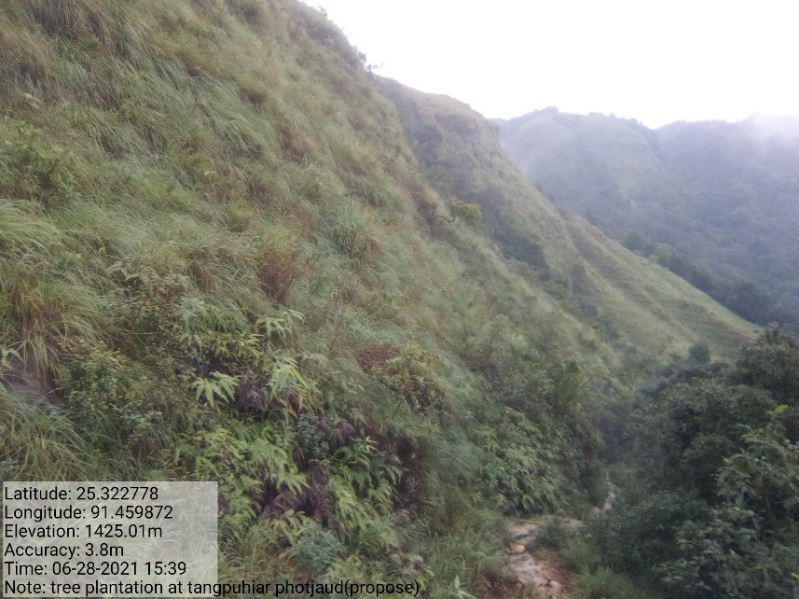
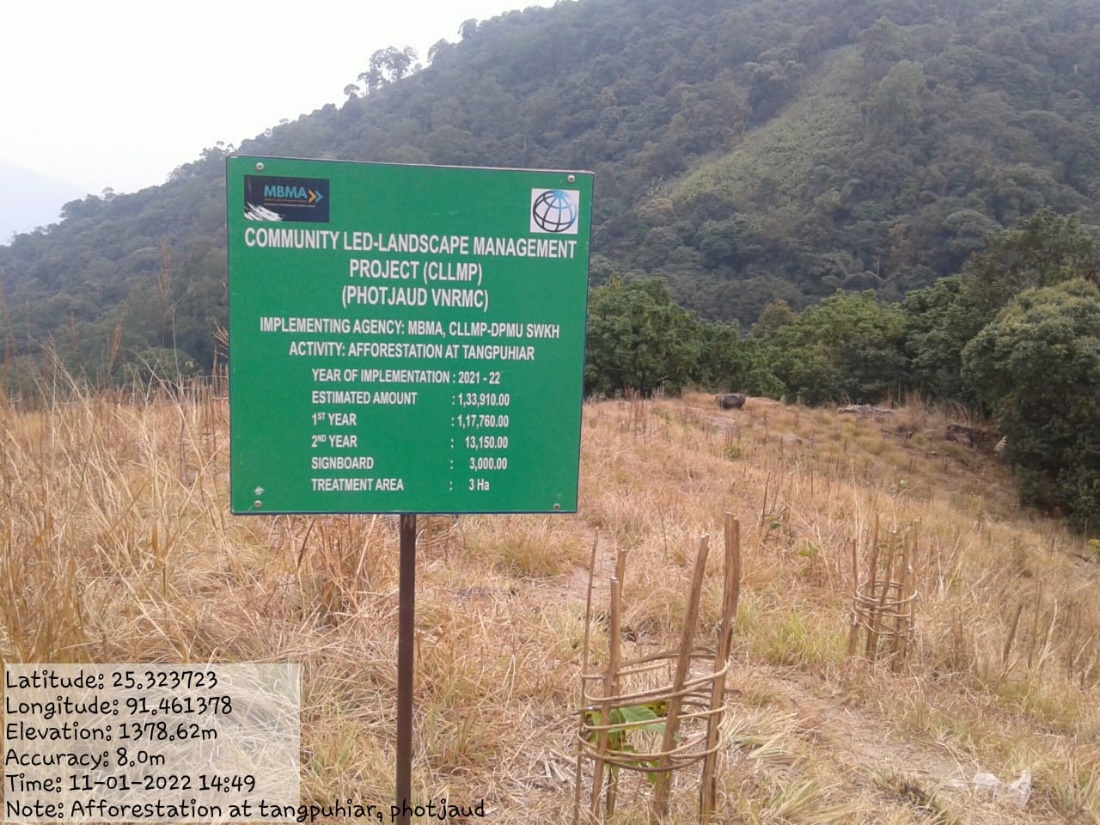
Fig: Afforestation at Tangpuhiar.
| 10. | Type of intervention | Site name | GPS co-ordinates | Amount sanctioned | Work status | |
|---|---|---|---|---|---|---|
| Afforestation at Saitsohphan | Saitsohphan | 25.321272 | 91.458475 | Rs.95,910 | Completed | |

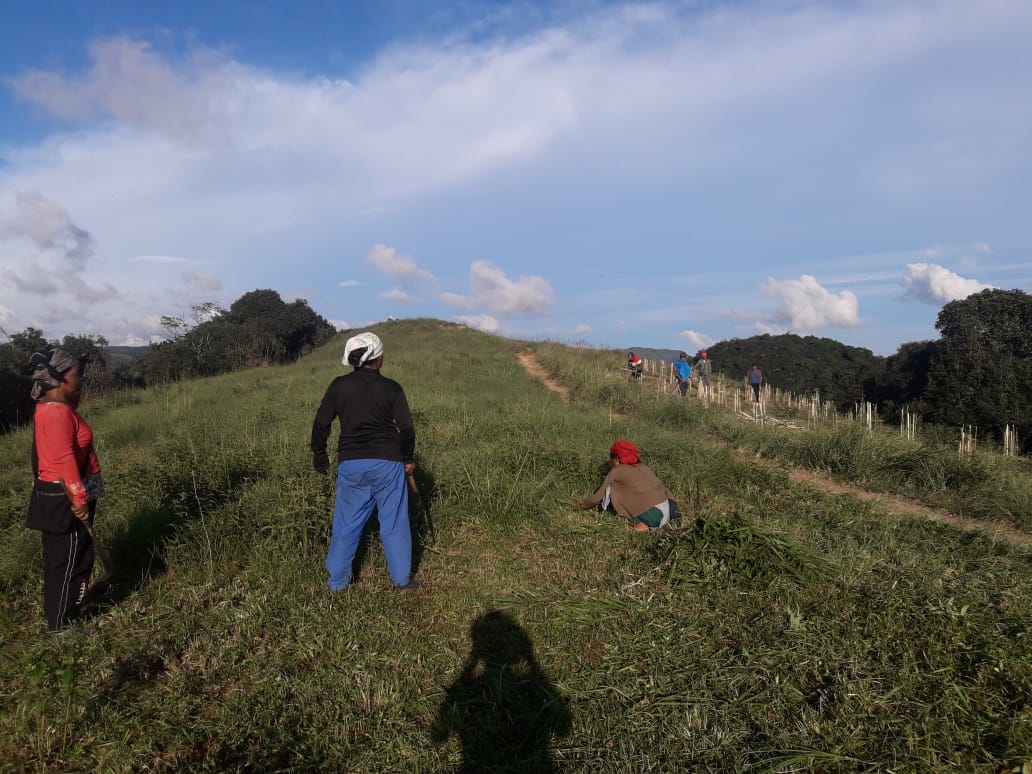
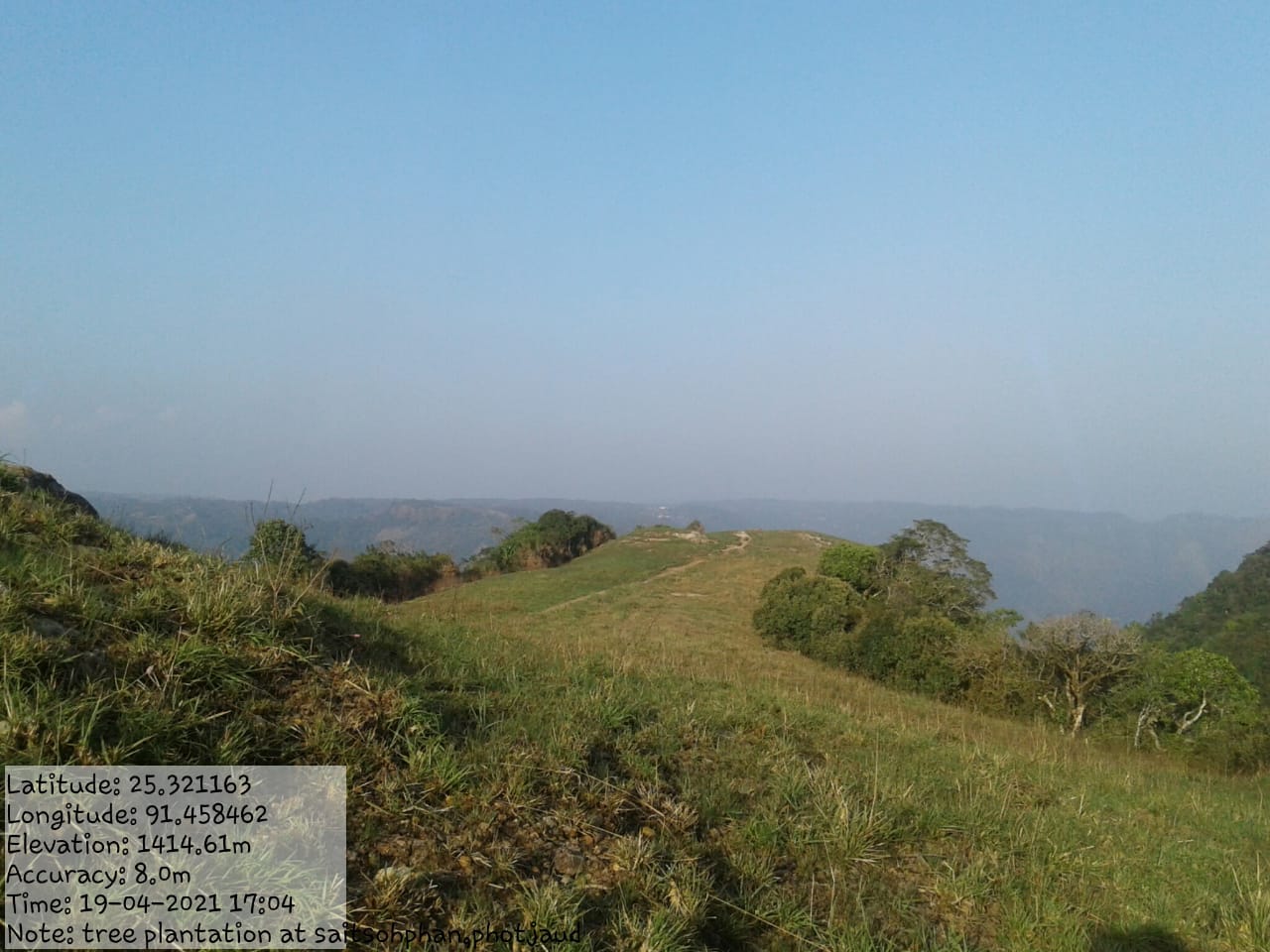
Fig: Afforestation at Saitsohphan.
| 11. | Type of intervention | Site name | GPS co-ordinates | Amount sanctioned | Work status | |
|---|---|---|---|---|---|---|
| CC checkdam gully plug at Phot Mawjaw | Phot Mawjaw | 25.324895 | 91.462206 | Rs.2,38,730 | Completed | |
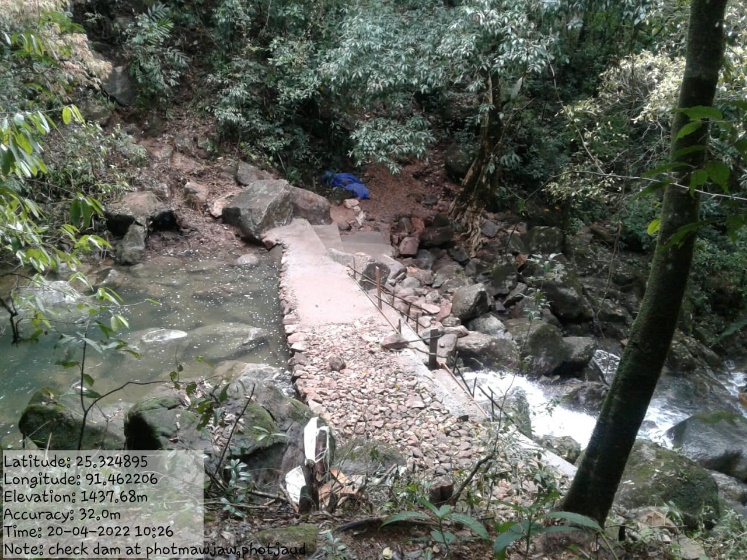
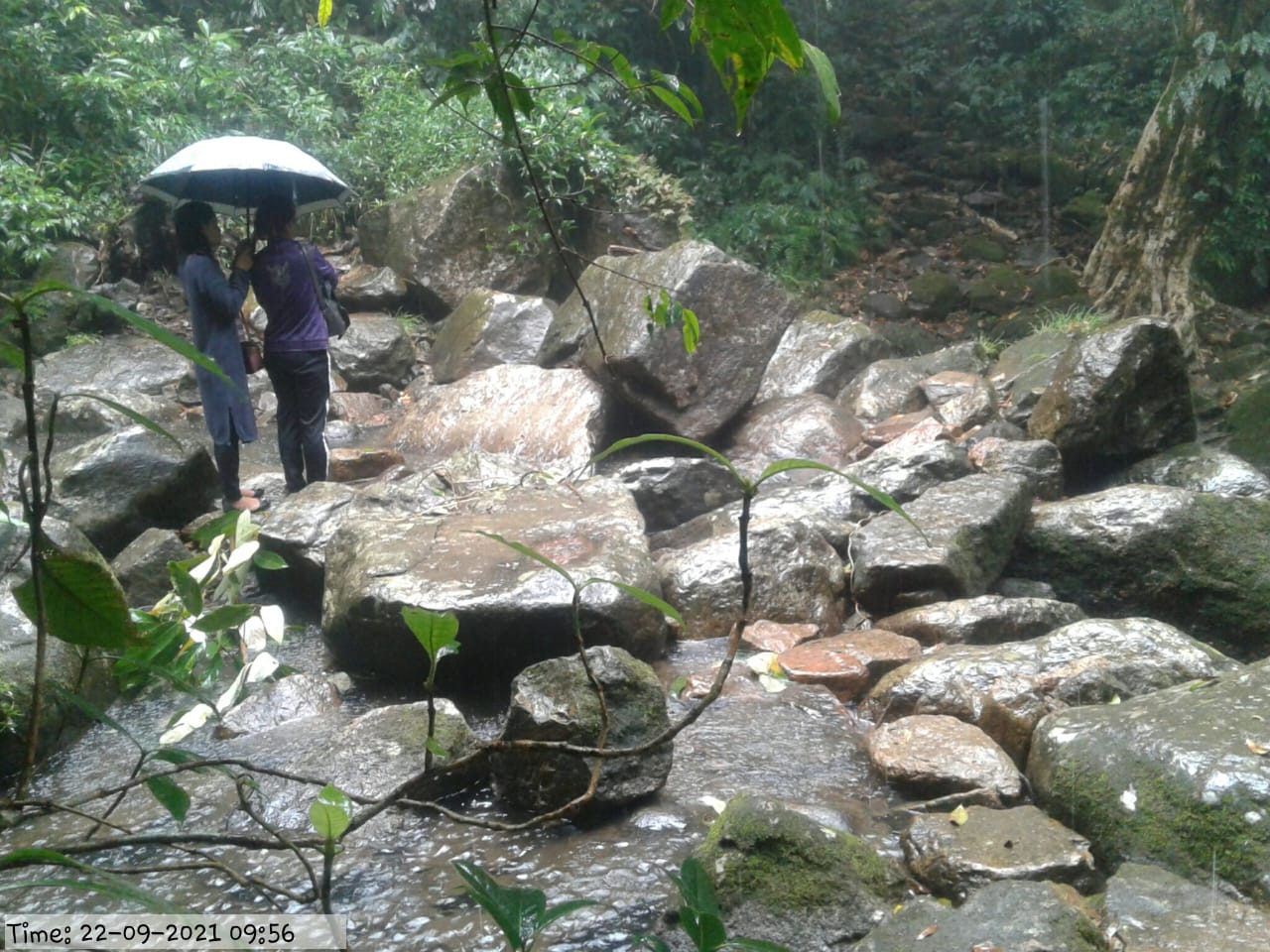
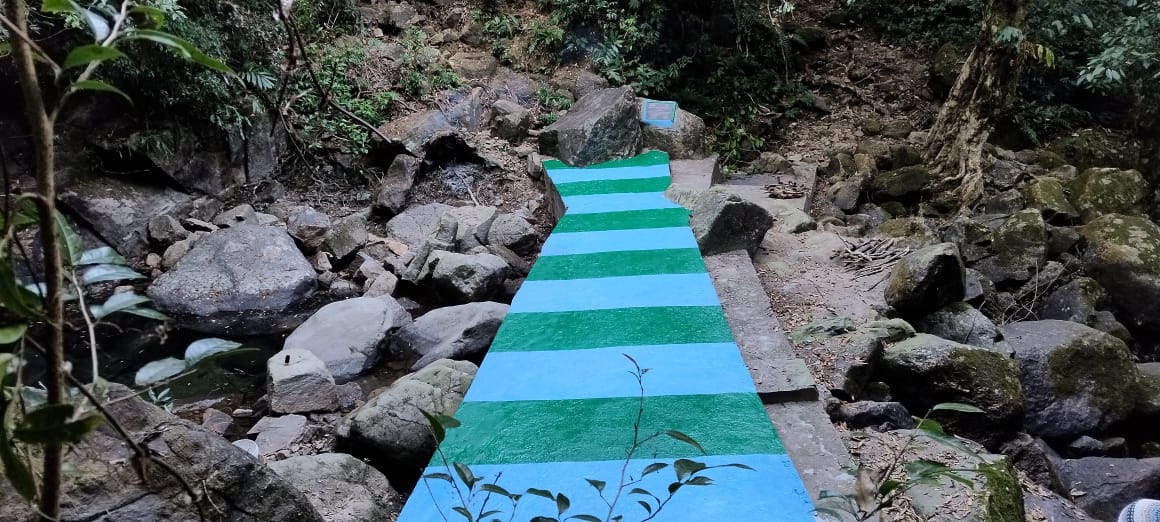
Fig: CC Checkdam gully plug at Phot Mawjaw.
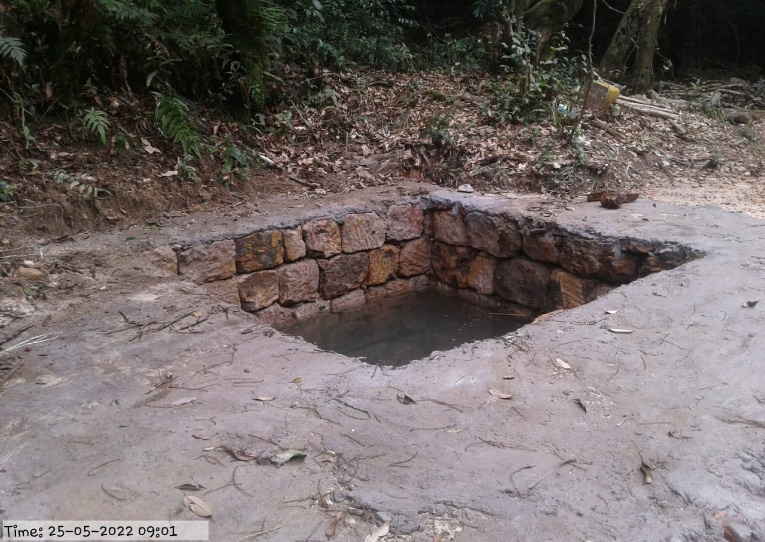
| 12. | Type of intervention | Site name | GPS co-ordinates | Amount sanctioned | Work status | |
|---|---|---|---|---|---|---|
| Spring Chamber at Twah Rainiang | Twah Rainiang | 25.325139 | 91.456094 | Rs.64,580 | Completed | |
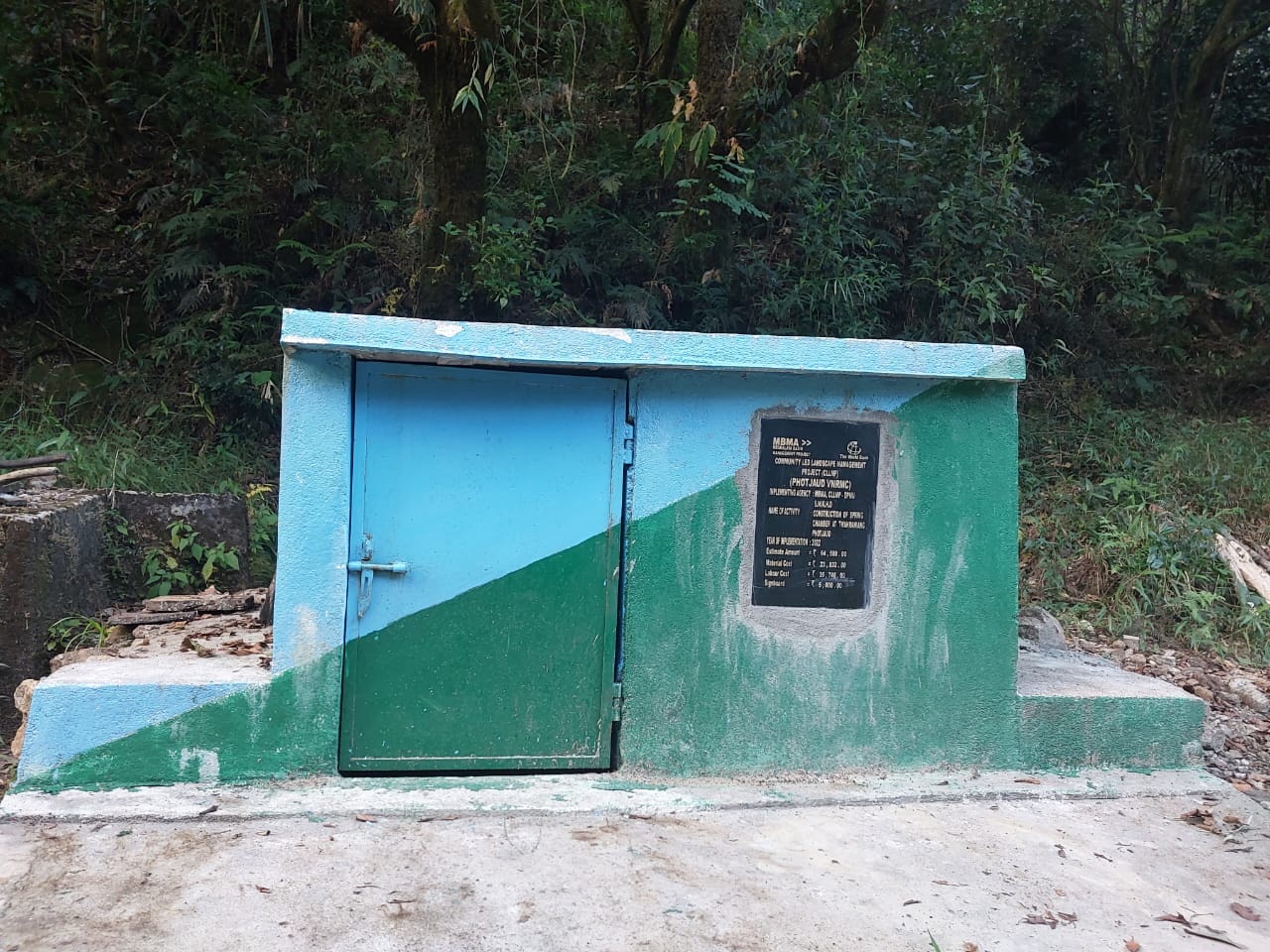
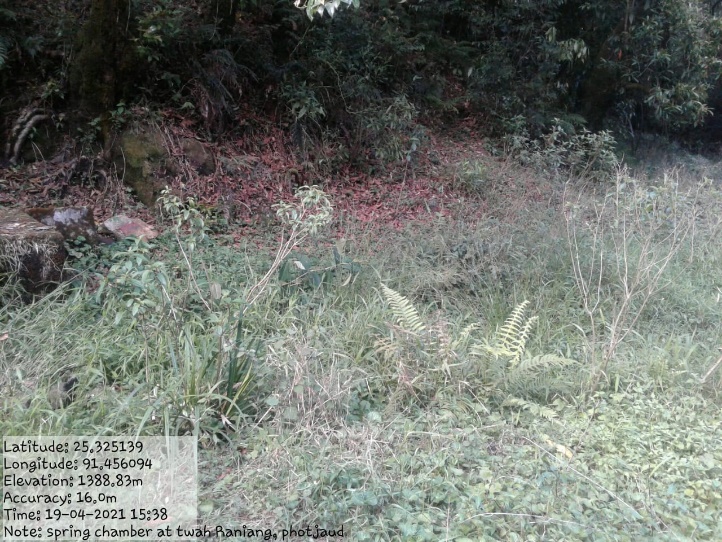
Fig: Spring Chamber at Twah Rainiang.
| 13. | Type of intervention | Site name | GPS co-ordinates | Amount sanctioned | Work status | |
|---|---|---|---|---|---|---|
| Dug out Pond at Saitsohphan | Saitsohphan | 25.321206 | 91.458002 | Rs.39,200 | Completed | |
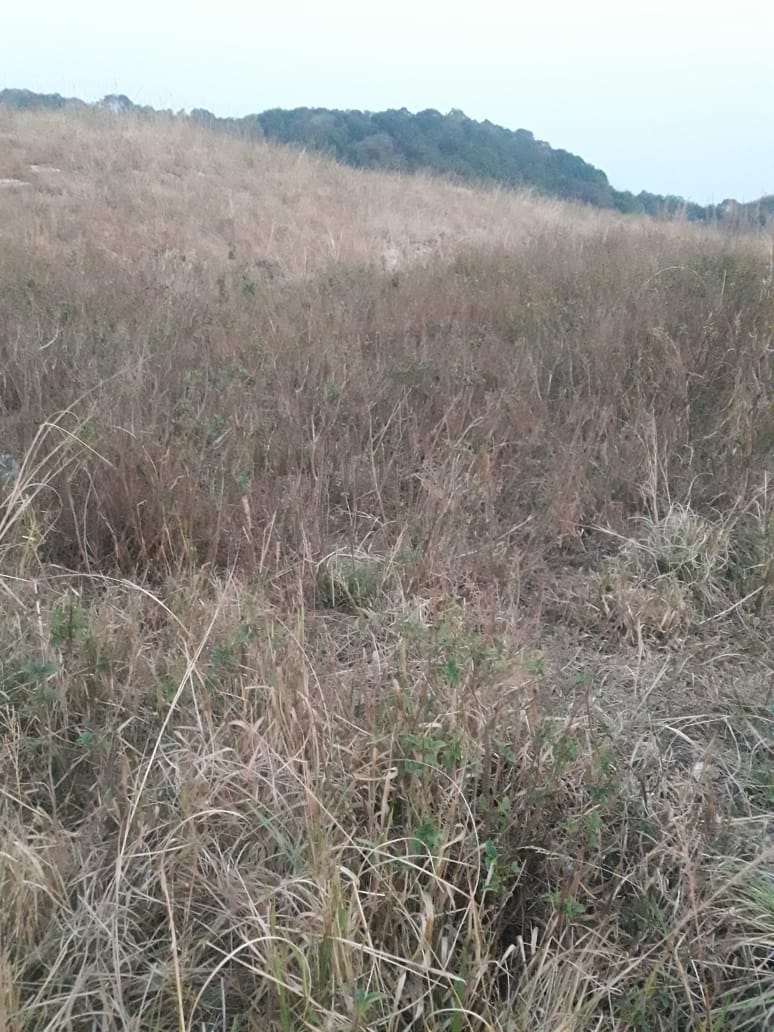
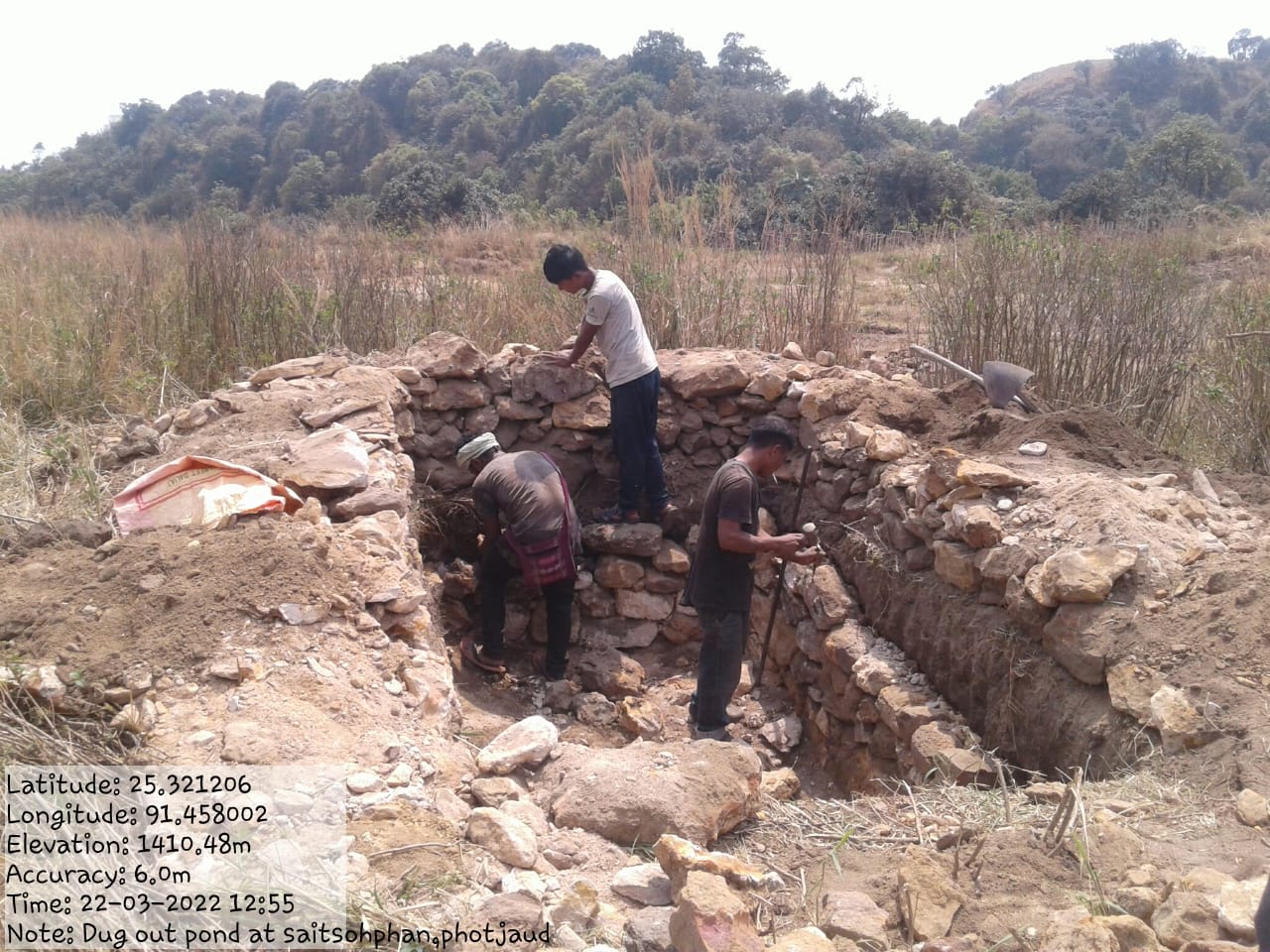

Fig: Dug out Pond at Saitsohphan.
| 14. | Type of intervention | Site name | GPS co-ordinates | Amount sanctioned | Work status | |
|---|---|---|---|---|---|---|
| CC Checkdam Gully Plug at Photshnongsan | Photshnongsan | 25.325016 | 91.459422 | Rs.1,75,690 | Completed | |
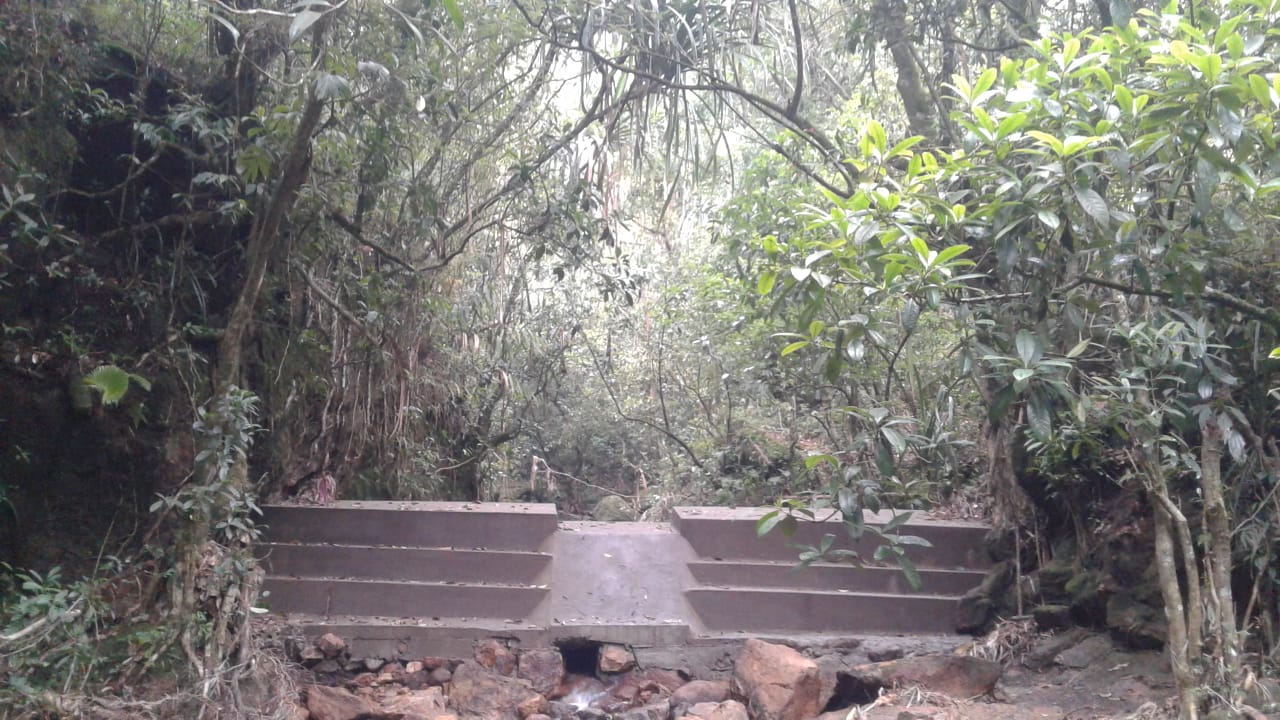
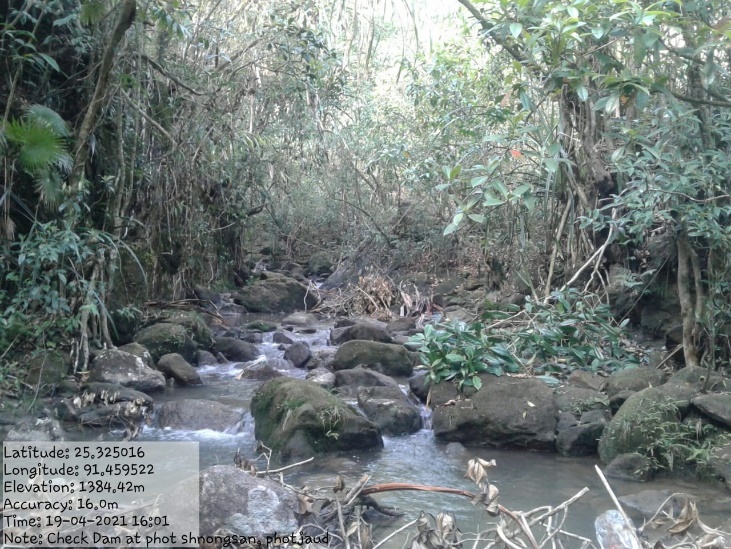
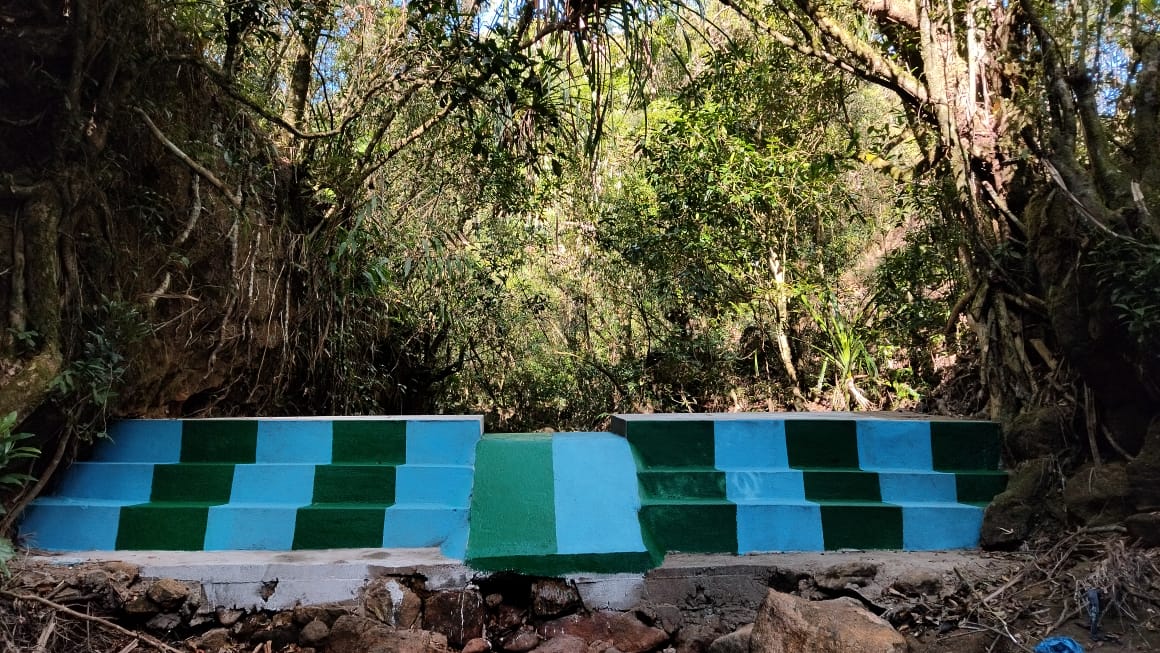
Fig: CC Checkdam Gully Plug at Photshnongsan.
| 15. | Type of intervention | Site name | GPS co-ordinates | Amount sanctioned | Work status | |
|---|---|---|---|---|---|---|
| Spring Chamber at Twahbah | Twahbah | 25.321629 | 91.450307 | Rs.73,750 | Completed | |
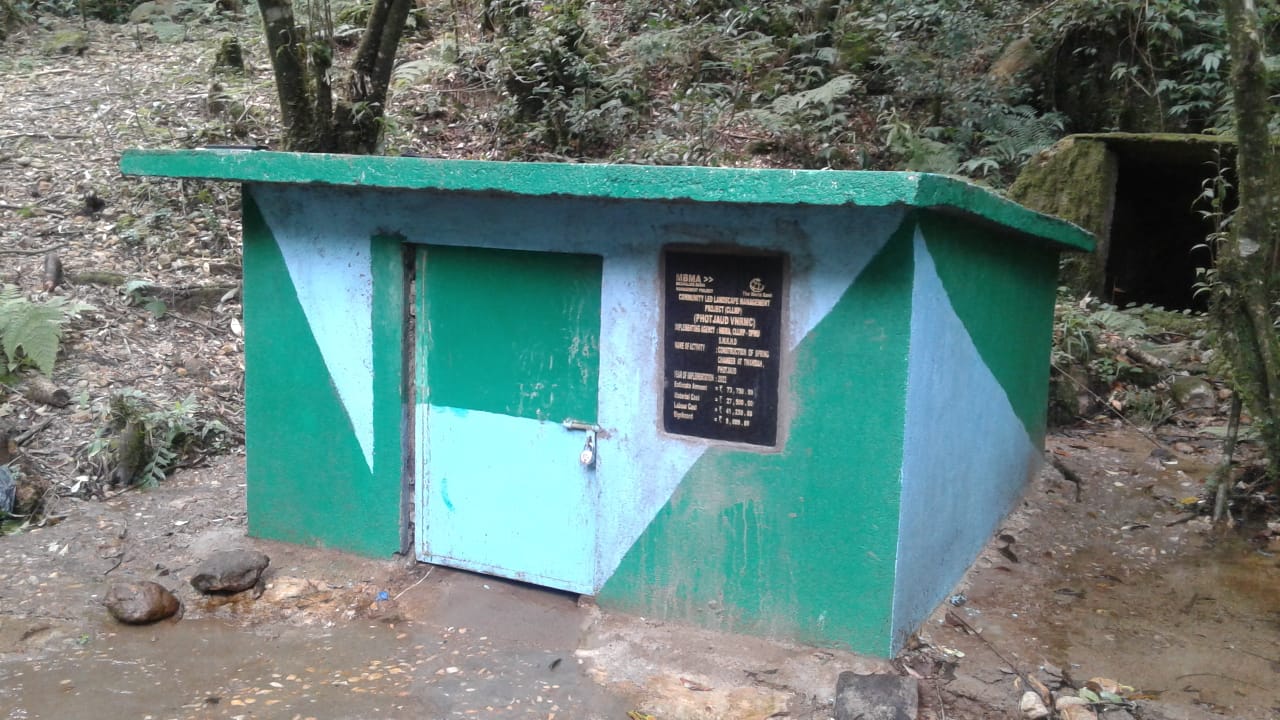
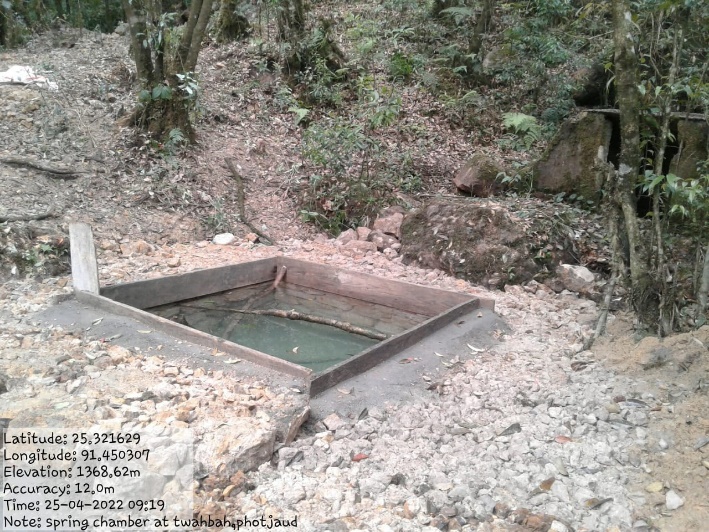
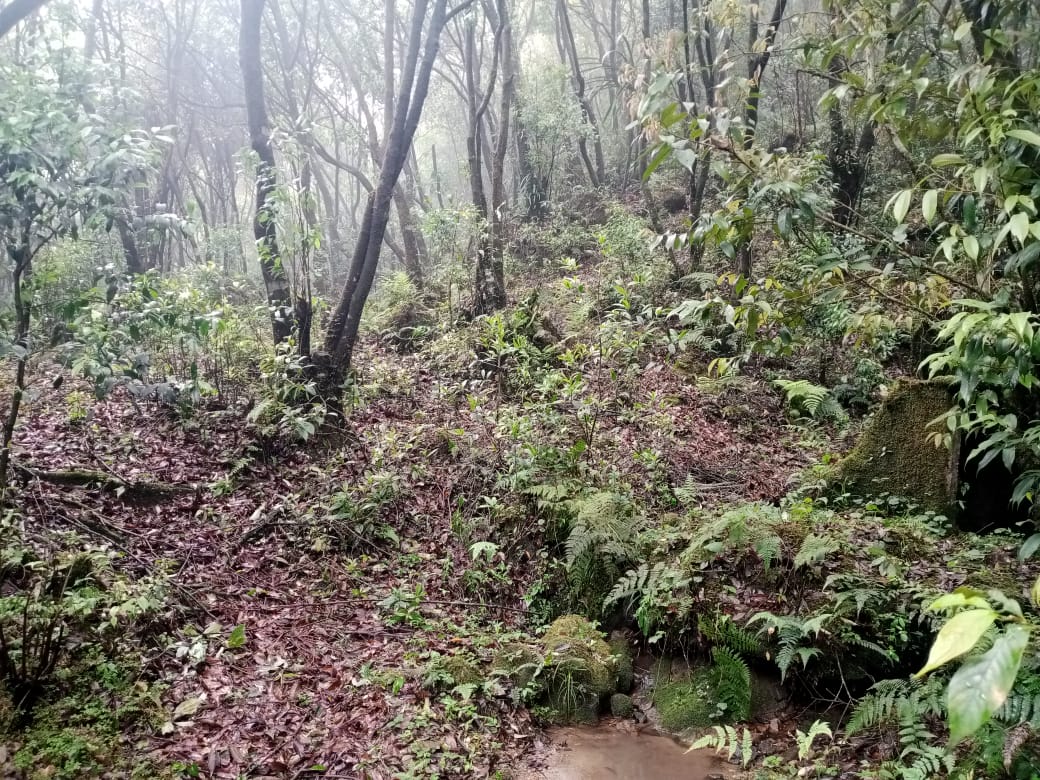
Fig: Spring Chamber at Twahbah.
| 16. | Type of intervention | Site name | GPS co-ordinates | Amount sanctioned | Work status | |
|---|---|---|---|---|---|---|
| Spring Chamber at Twahmawsyiar | Twahmawsyiar | 25.324771 | 91.452396 | Rs.73,750 | Completed | |
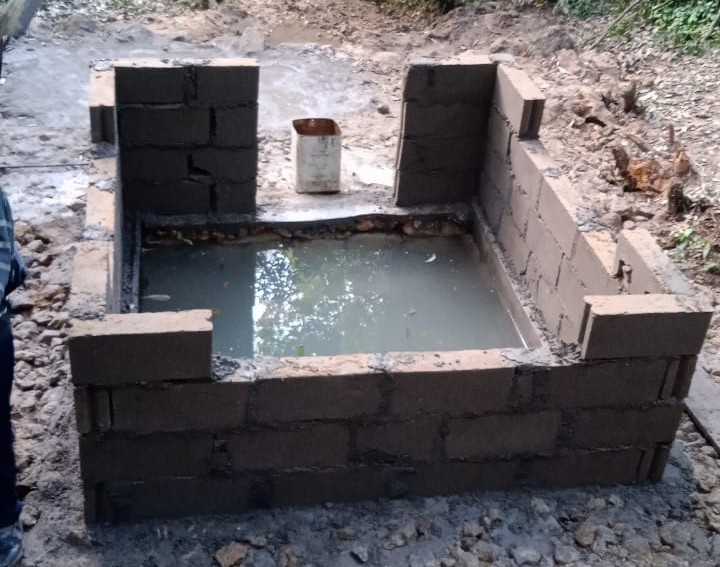
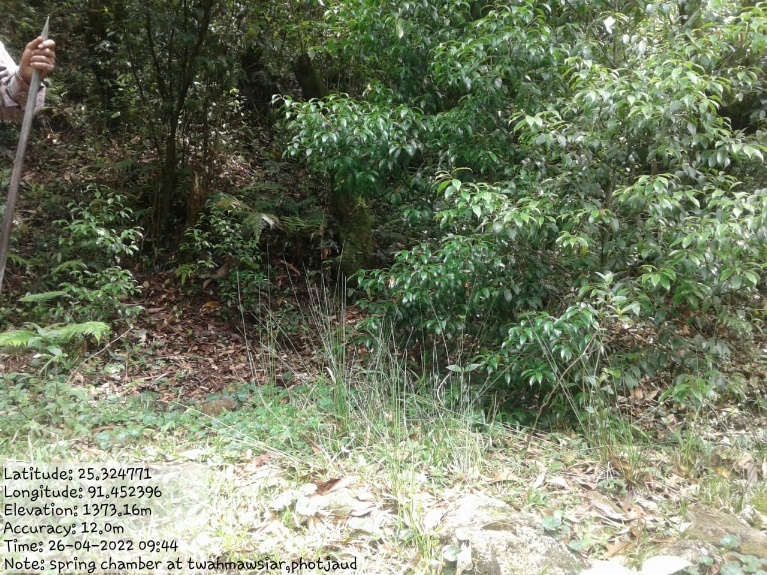
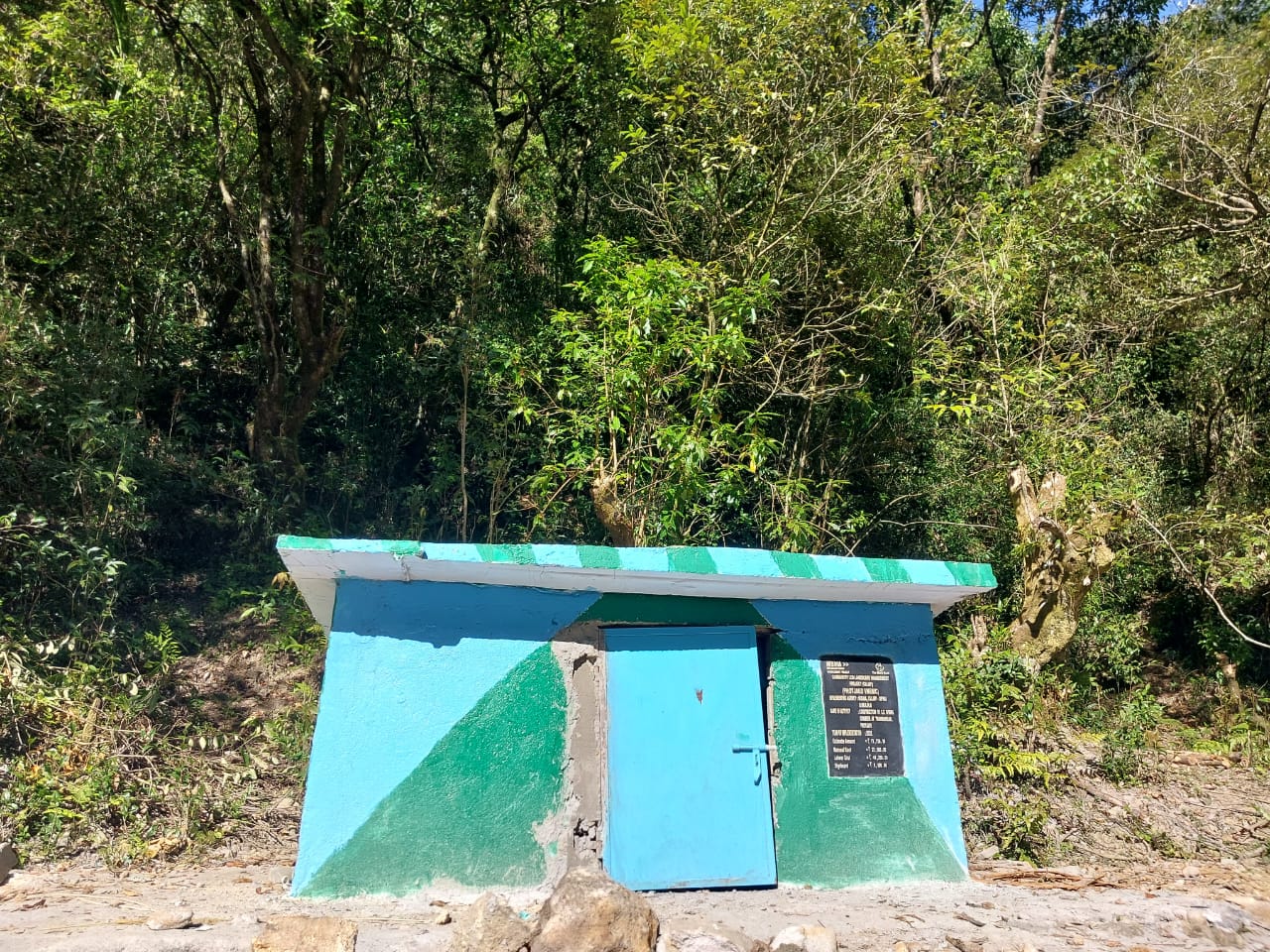
Fig: Spring Chamber at Twahmawsyiar.
| 17. | Type of intervention | Site name | GPS co-ordinates | Amount sanctioned | Work status | |
|---|---|---|---|---|---|---|
| Afforestation at Domsohreikhnep | Domsohreikhnep | 25.32787 | 91.462944 | Rs.77,810 | Completed | |
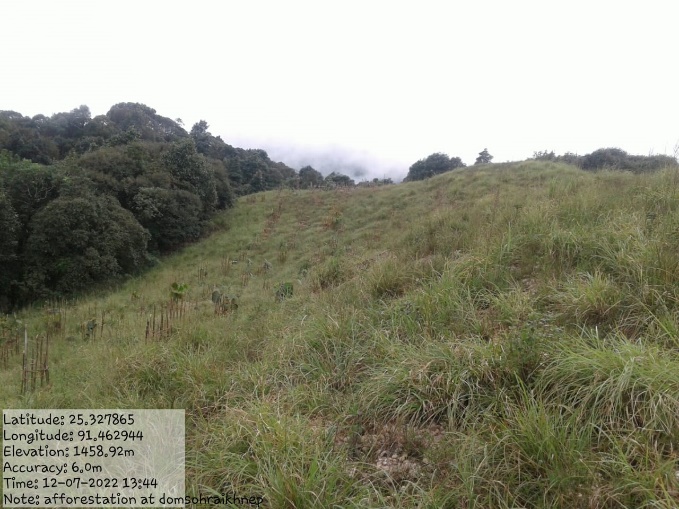
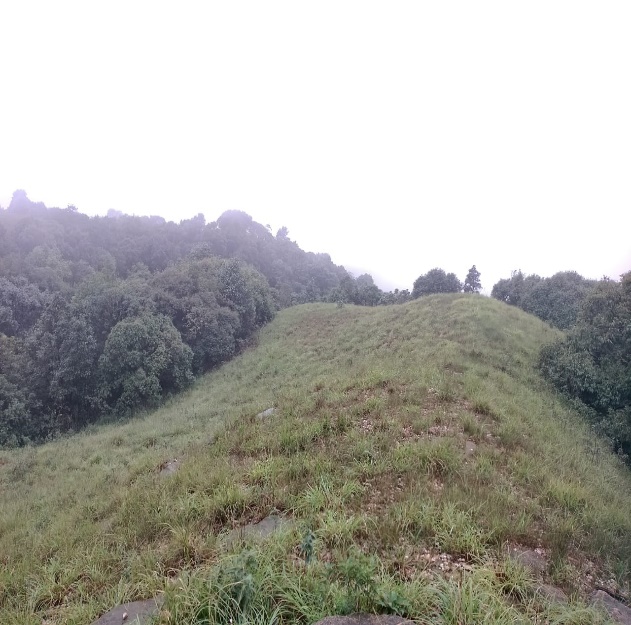
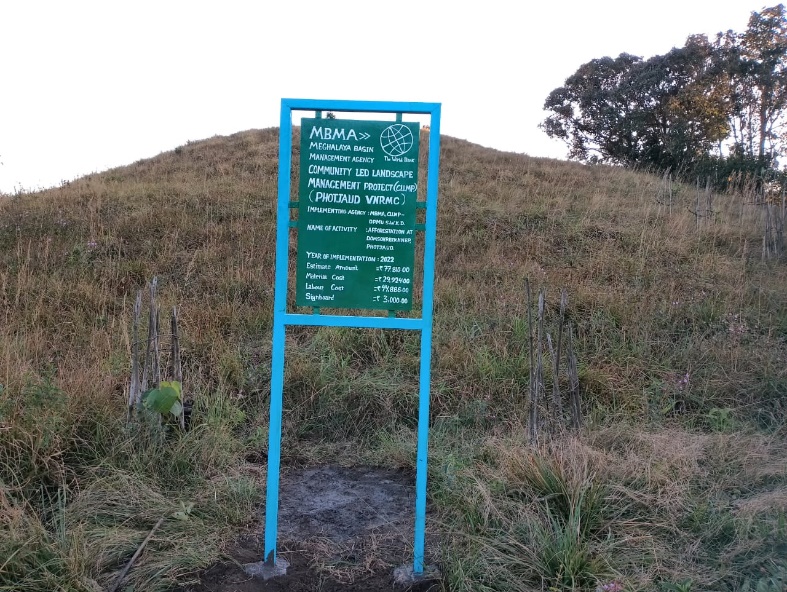
Fig: Afforestation at Domsohreikhnep.
| 18. | Type of intervention | Site name | GPS co-ordinates | Amount sanctioned | Work status | |
|---|---|---|---|---|---|---|
| CC Checkdam cum site beautification for tourist spot at Tynrong Mawjaw. | Tynrong Mawjaw | 25.32632 | 91.464893 | Rs.5,00,000 | Completed | |
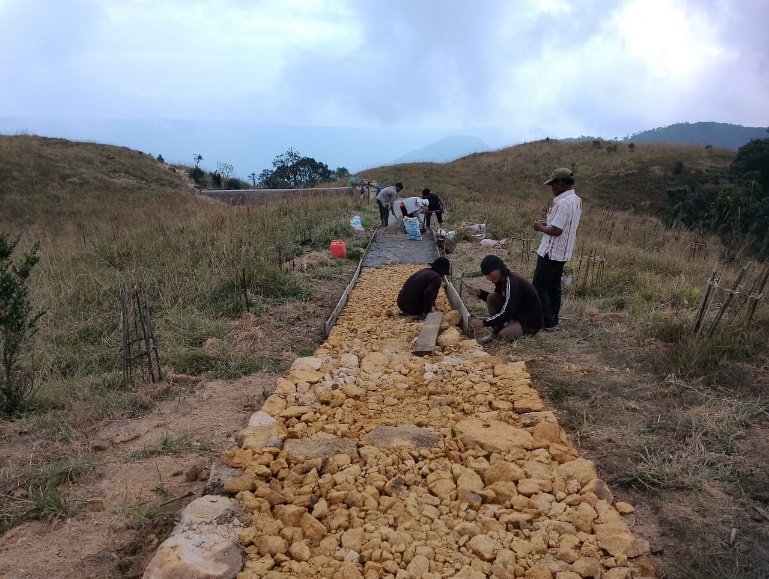
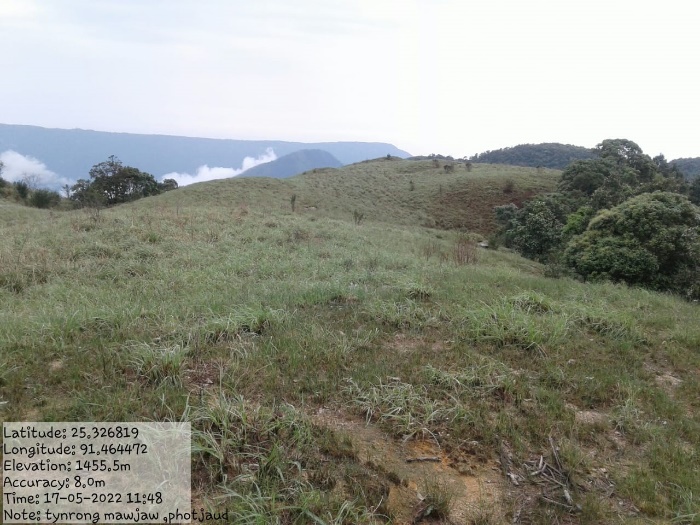
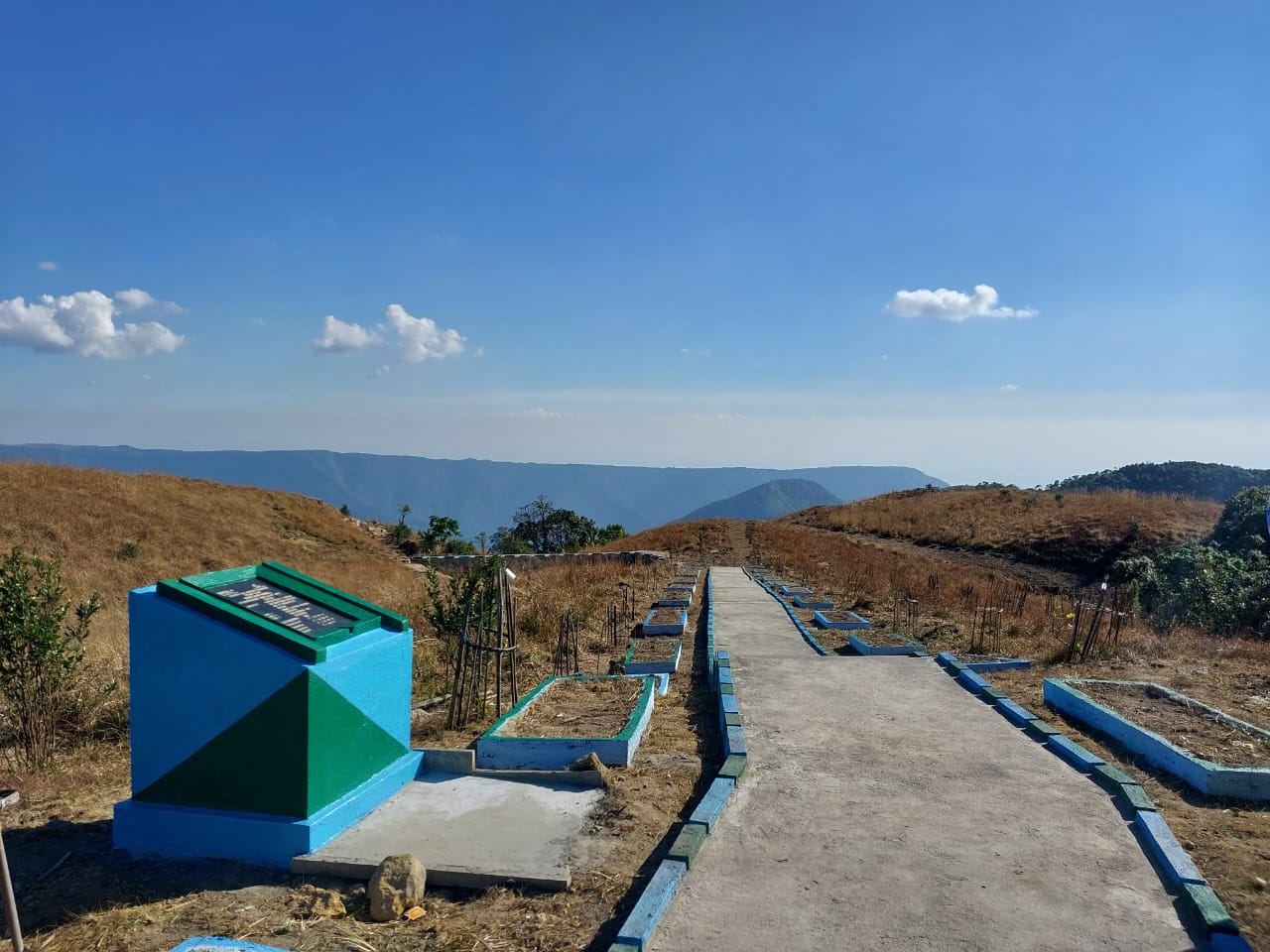
Fig: CC Checkdam cum site beautification for tourist spot at Tynrong Mawjaw.
11.Fund Status:
Fund Released to VNRMC (Project Implementation)- Rs.26,55,000 Total No. of Work Order Issued- 18 |
|||||
| Activity Name | Amount Sanction | Amount Spent | Work Order Issued Date | Start Date | End Date |
| Erosion control wall at Compound Iingmane Dongpdeng | Rs.2,30,410 | Rs.2,30,410 | 25th Sept 2019 | 10th Dec 2019 | 30th Jan 2020 |
| SC and staggered trenches at Phodsangshong | Rs.45,760 | Rs.45,760 | 25th Sept 2019 | 10th Dec 2019 | 25th Jan 2020 |
| SC and staggered trenches at Tlongjaud | Rs.69,750 | Rs.69,750 | 25th Sept 2019 | 1st Jan 2020 | 28th Feb 2020 |
| Community Nursery at Shongsang | Rs.2,97,280 | Rs. 2,97,280 | 2nd March 2020 | 2nd Nov 2020 | 29th Aug 2022 |
| Afforestation at Shnongsan | Rs.2,30,000 | Rs. 2,30,000 | 15th July 2020 | 18th Feb 2020 | 30th Jul 2022 |
| Afforestation at Domiappudro | Rs.78,650 | Rs. 78,650 | 16th July 2021 | 9th Aug 2021 | 15th Jul 2022 |
| Afforestation at Tynrong Mawjam | Rs.1,33,910 | Rs. 1,33,910 | 16th July 2021 | 9th Aug 2021 | 15th Jul 2022 |
| Afforestation at Tiehbah | Rs.95,910 | Rs. 95,910 | 16th July 2021 | 9th Aug 2021 | 15th Jul 2022 |
| Afforestation at Tangpuhiar | Rs.1,33,910 | Rs. 1,33,910 | 16th July 2021 | 9th Aug 2021 | 15th Jul 2022 |
| Afforestation at Saitsohphan | Rs.95,910 | Rs. 95,910 | 16th July 2021 | 9th Aug 2021 | 15th Jul 2022 |
| CC Checkdam gully plug at Phot Mawjaw | Rs.2,38,730 | Rs. 2,38,730 | 14th Dec 2021 | 25th Jan 2022 | 26th Mar 2022 |
| Spring Chamber at Twah Rainiang | Rs.64,580 | Rs. 64,580 | 18th Jan 2022 | 17th Feb 2022 | 28th Feb 2022 |
| Dug out pond at Saitsohphan | Rs.39,200 | Rs. 39,200 | 18th Jan 2022 | 19th Feb 2022 | 26th Feb 2022 |
| CC Checkdam Gully Plug at Photshnongsan | Rs.1,75,690 | Rs. 1,75,690 | 18th Jan 2022 | 17th Feb 2022 | 16th Mar 2022 |
| Spring Chamber at Twahbah | Rs.73,750 | Rs. 73,750 | 10th March 2022 | 4th May 2022 | 19th May 2022 |
| Spring Chamber at Twahmawsyiar | Rs.73,750 | Rs. 73,750 | 10th March 2022 | 4th May 2022 | 19th May 2022 |
| Afforestation at Domsohreikhnep | Rs.77,810 | Rs. 77,810 | 31st March 2022 | 27th Jun 2022 | 30th Jul 2022 |
| CC Checkdam cum site beautification for tourist spot at Tynrong Mawjaw | Rs.5,00,000 | Rs. 5,00,000 | 31st May 2022 | 27th Jun 2022 | 30th Nov 2022 |
12. GROUND TESTIMONIALS:

Shri. Twingklingstar Shangdiar
Village Headman & President of Photjaud VNRMC.
“I feel very happy and delighted to get this oppourtunity to tell everyone about the working of the CLLMP DPMU South West Khasi Hills District in our village since the year 2019. Me personally as a village Headman I would first of all like to express my gratitute towards this Project and the long list of benefits that comes with implementing the various intervention within my village. This Project has been a great blessing to our people in imparting knowledge and understanding on conserving land, water and forest and has been inclusive in providing job opportunities to many youth, women and men. Through this project, we have been able to construct many Spring Chambers to meet the water requirement, Erosion Control wall to prevent the yearly occurance of landslide in the church compound, a Nursery, Afforestation sites, Checkdam and many other intervention in our VNRMC. The coming of the CLLM Project in our village has bear its early fruits in which there has been a change in the concept of the people in viewing the environtment and its surrounding. This was proven true as I have noticed that since the people of my village have accepcted the project to be implemented in the village, they have learn to accept to respect nature, also there has been no man made forest fires in the village since 2019, as people are more aware of the effects of it and for that I am thankful towards the CLLMP team as a whole ”
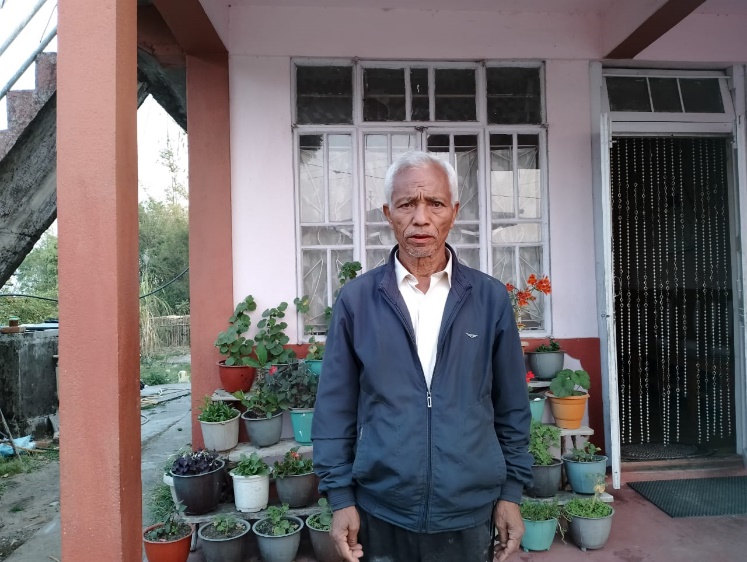
Mr.Waterland Shylla
Photjaud Book Keeper
As a Book Keeper of my village I have learned how to maintain and update all the books of records such as the Payment Vouncher, Minute Book, Cheque Issue Register, Cash Book and Purchase Register. All the staff and EE’s have been vey patient and helpful to clear all my doubts. I would have not learned such paper works if it was not because of the oppourtunity that I get to work through this office in our village.
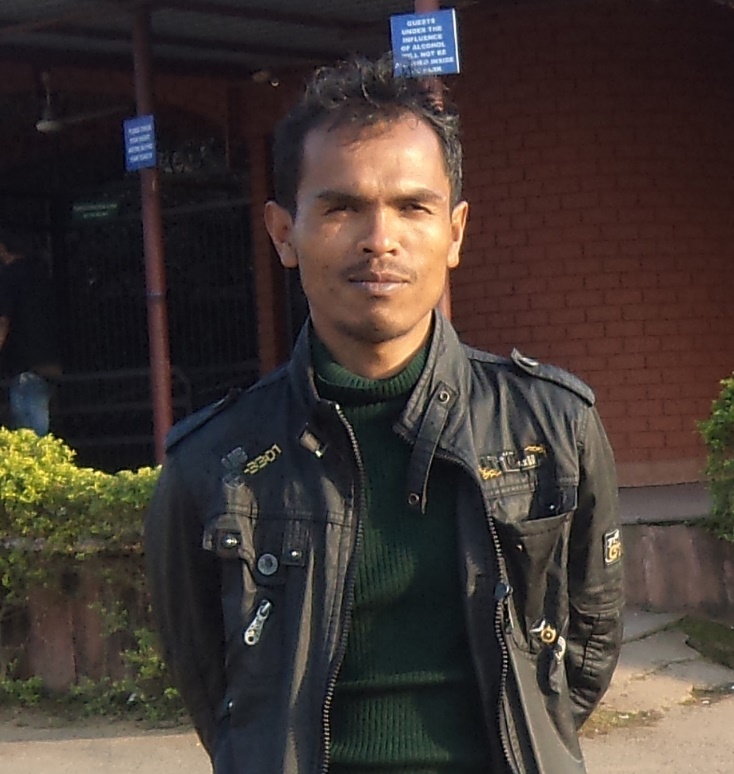
Mr.Trustfulman Shylla
Purchase Committee Member
I am very grateful toward this office for all the good work done in my village. Personally,my experience with the way CLLMP works is that it is very committed to the community-led resource management and they has implement it well.
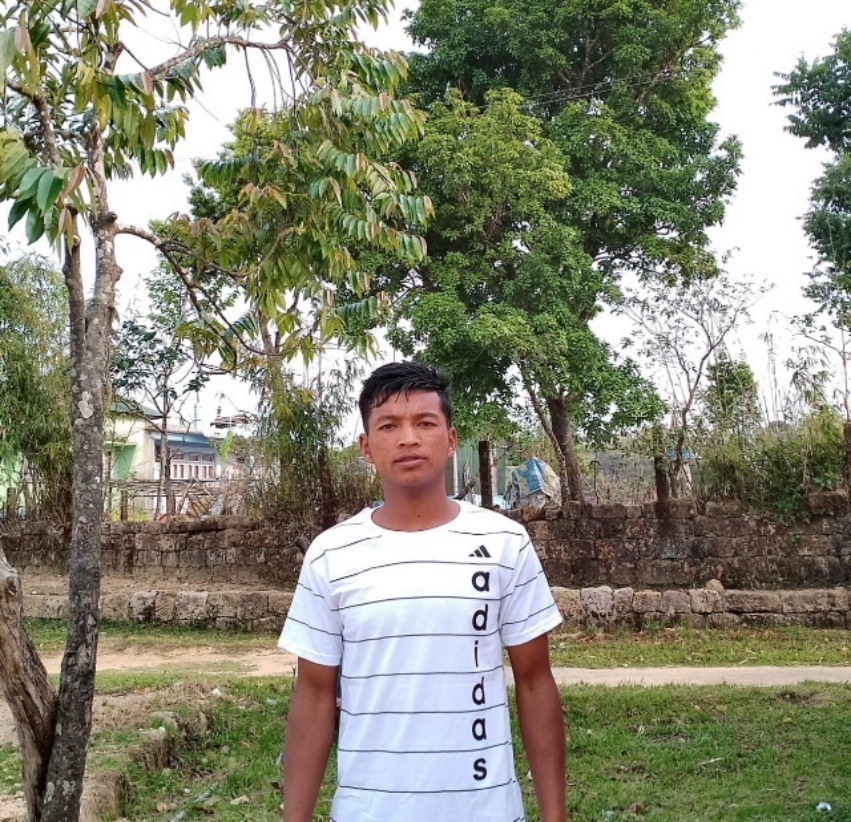
Mr. Iaraplang Shylla
VCF M&E
According to Mr. Iaraplang Shylla, the training received from Mr.Kegitar Lyndoh
DM-M&E and his advice throughout the 4 years have been very helpful to him and he also shares them with the other VNRMC members. As a youth I am happy to work as a VCF and get a chance to represent my village. CLLMP have given me the opportunity to learn and explore and as I get to play my part in contributing for the betterment of my surroundings while I am still young and healthy, I will carry the knowledge received for the years to come.
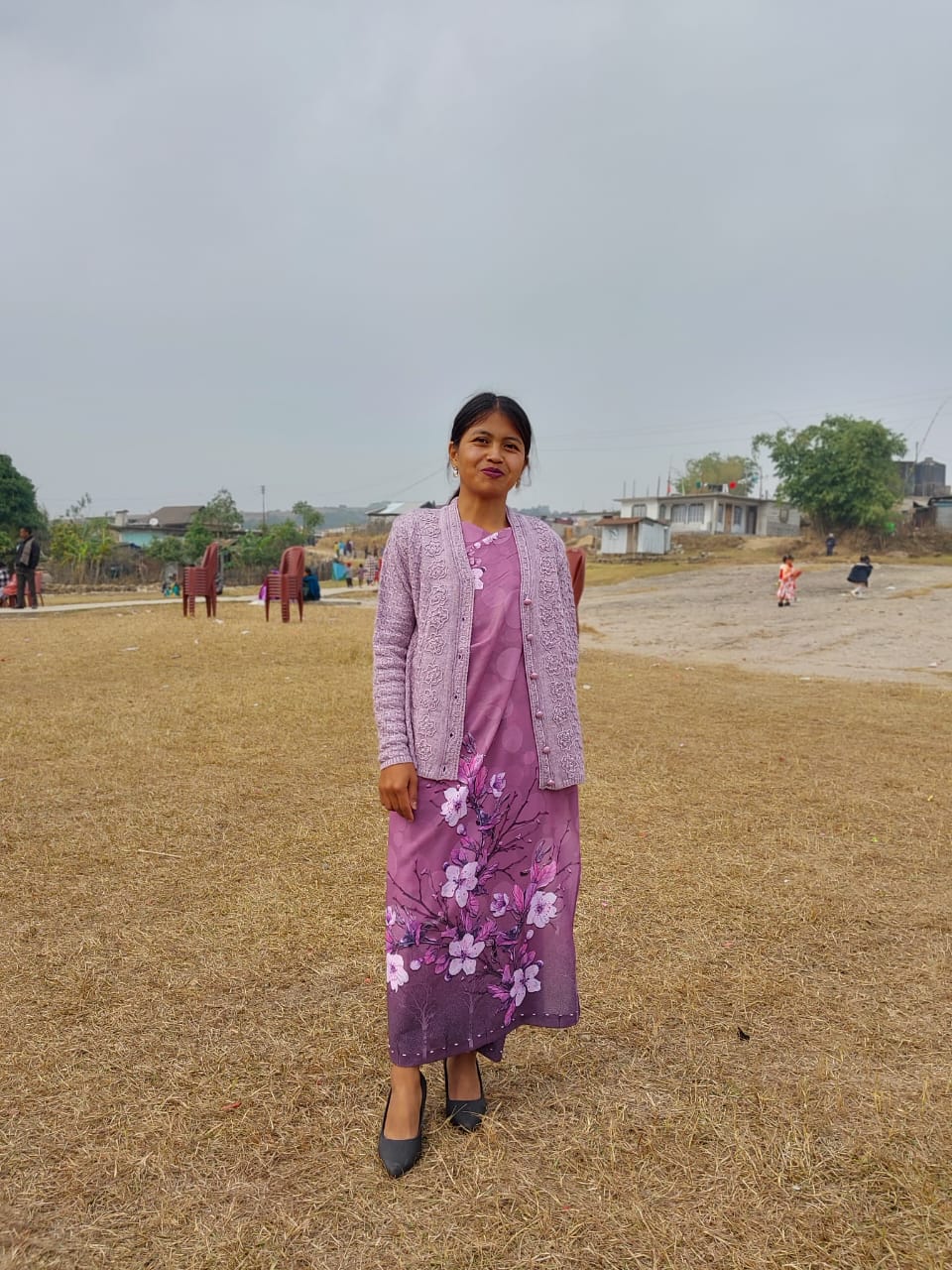
Beatrice Lyngkhoi
VCF Environment
This Project have given me a chance to learn many new things which previously, I was unaware of. I have gathered much knowledge regarding the importance of conserving nature and its rich resources. To name a few, I would have not known how to test the quality of the water in our spring if it was not through Spring Mapping (Water discharge, Water Quality), or would I have known about the height of the tree, the Clear Bole, the size of the tree or the girth as I have learned from the Forest Management Plan training received from Kong Niwancy Bareh.
----------------------------------*****************-------------------------------